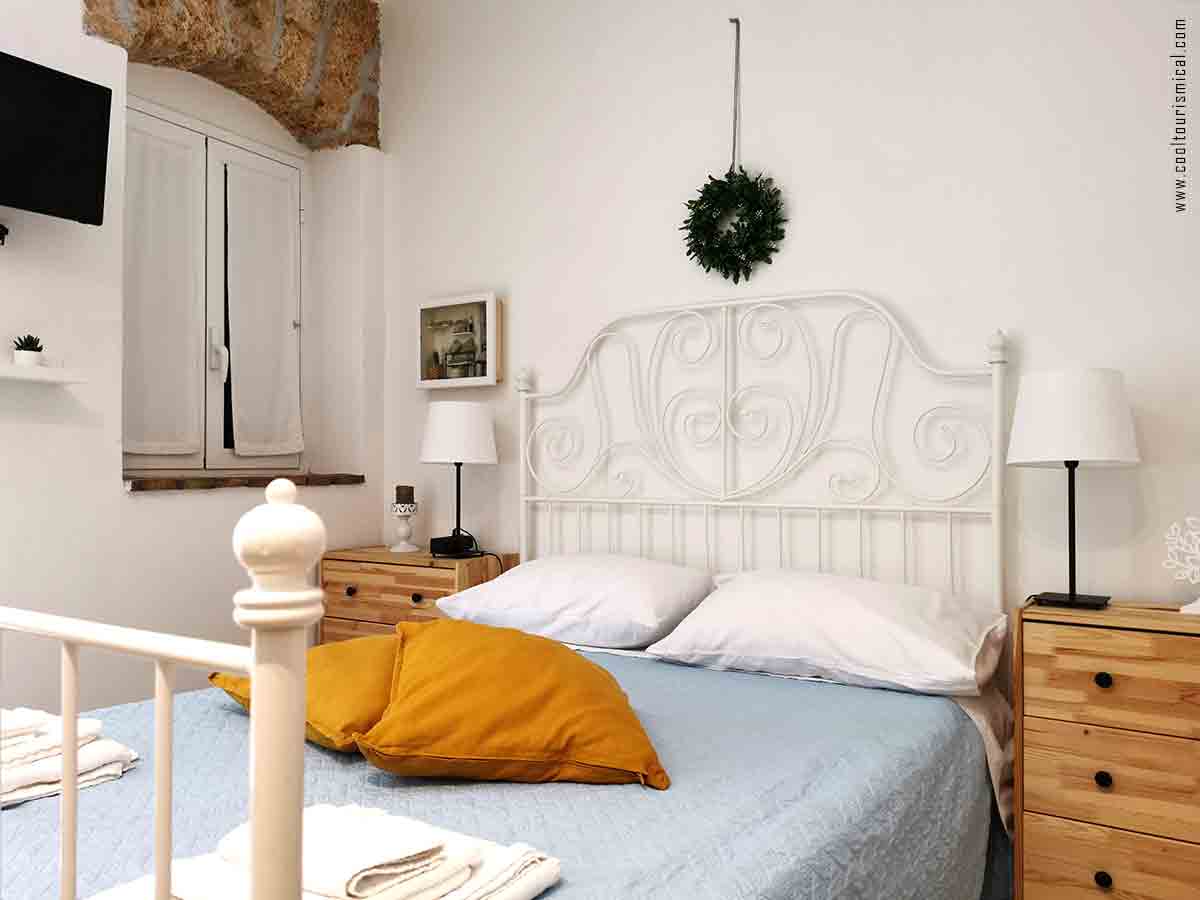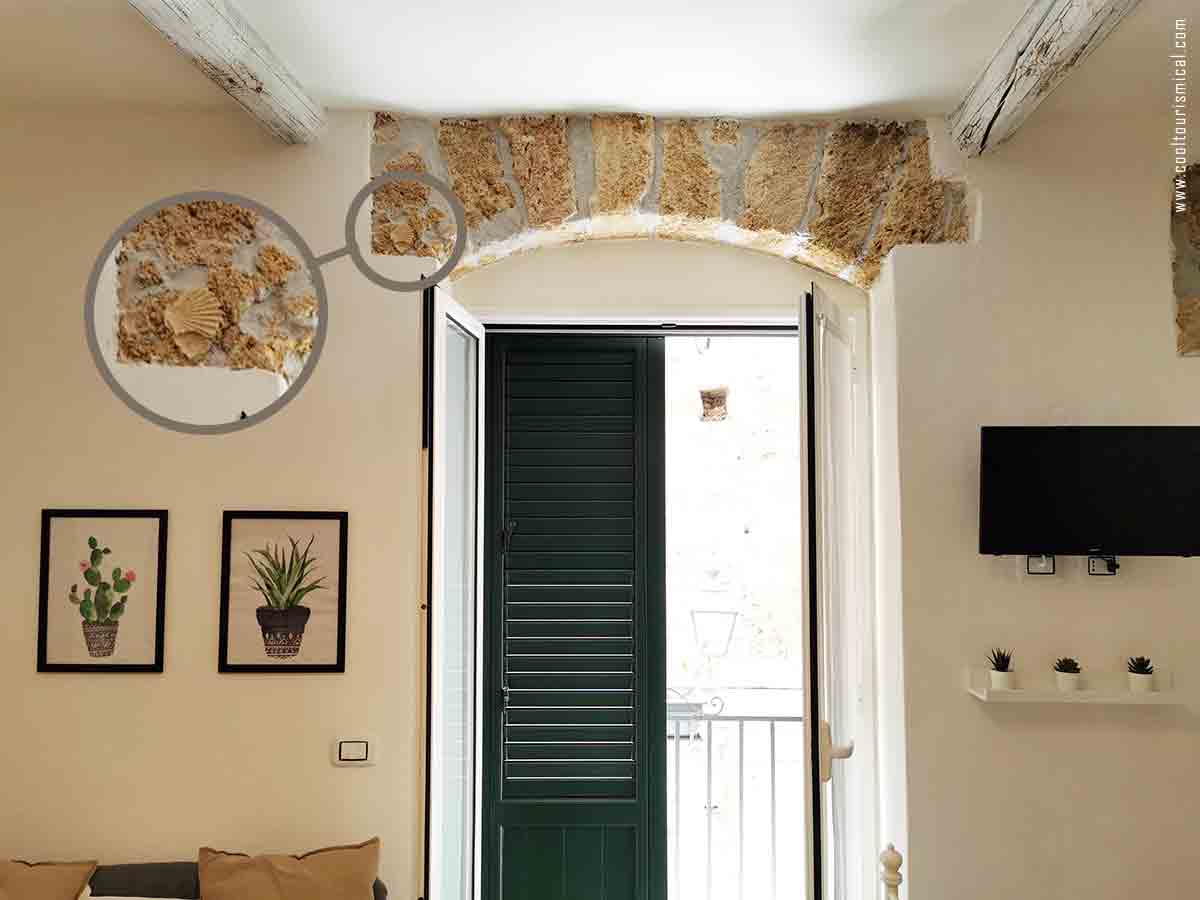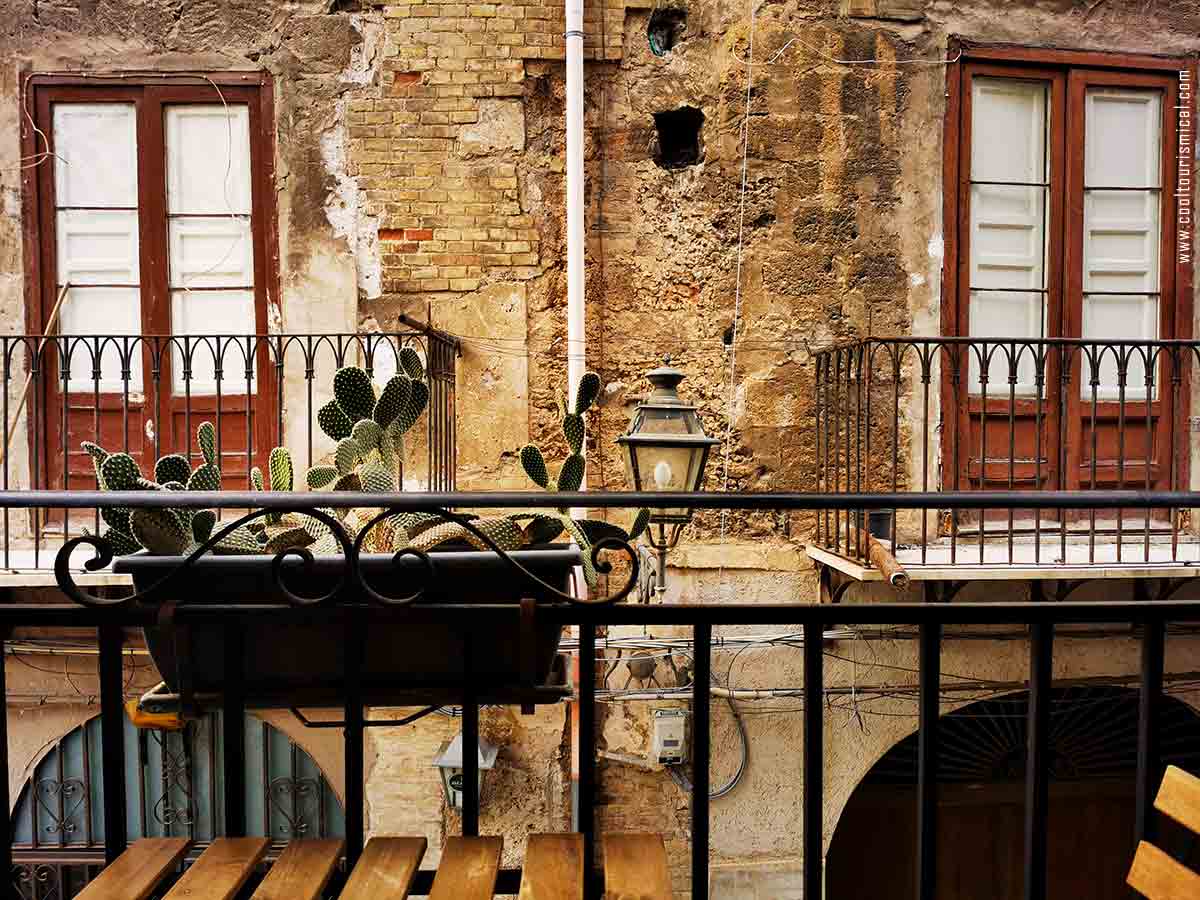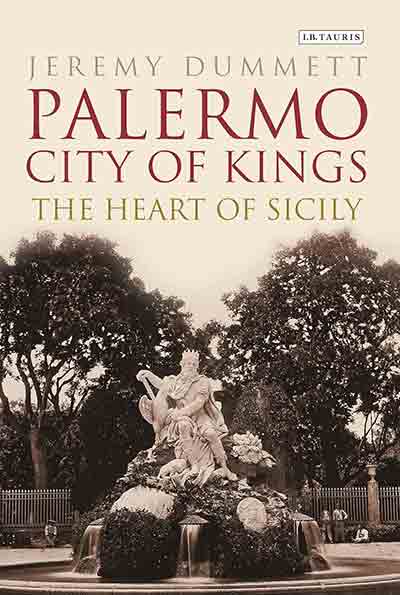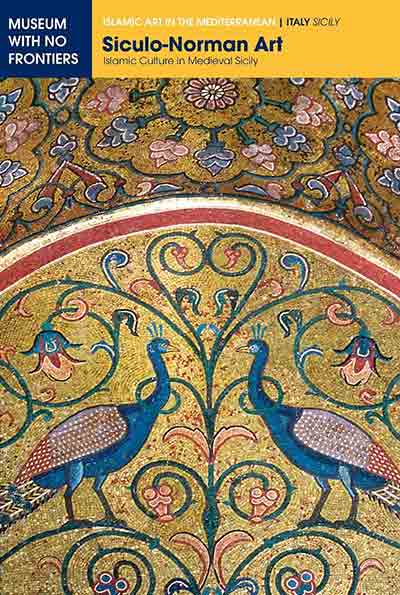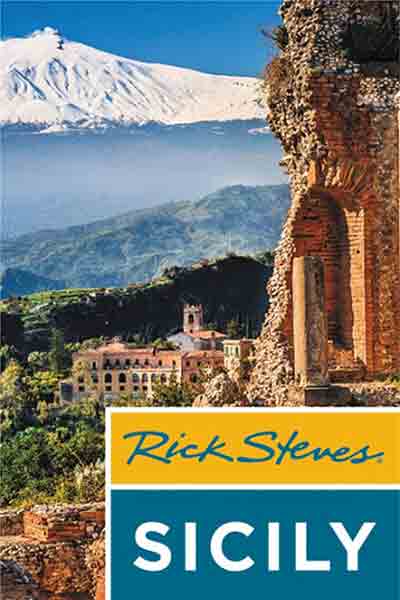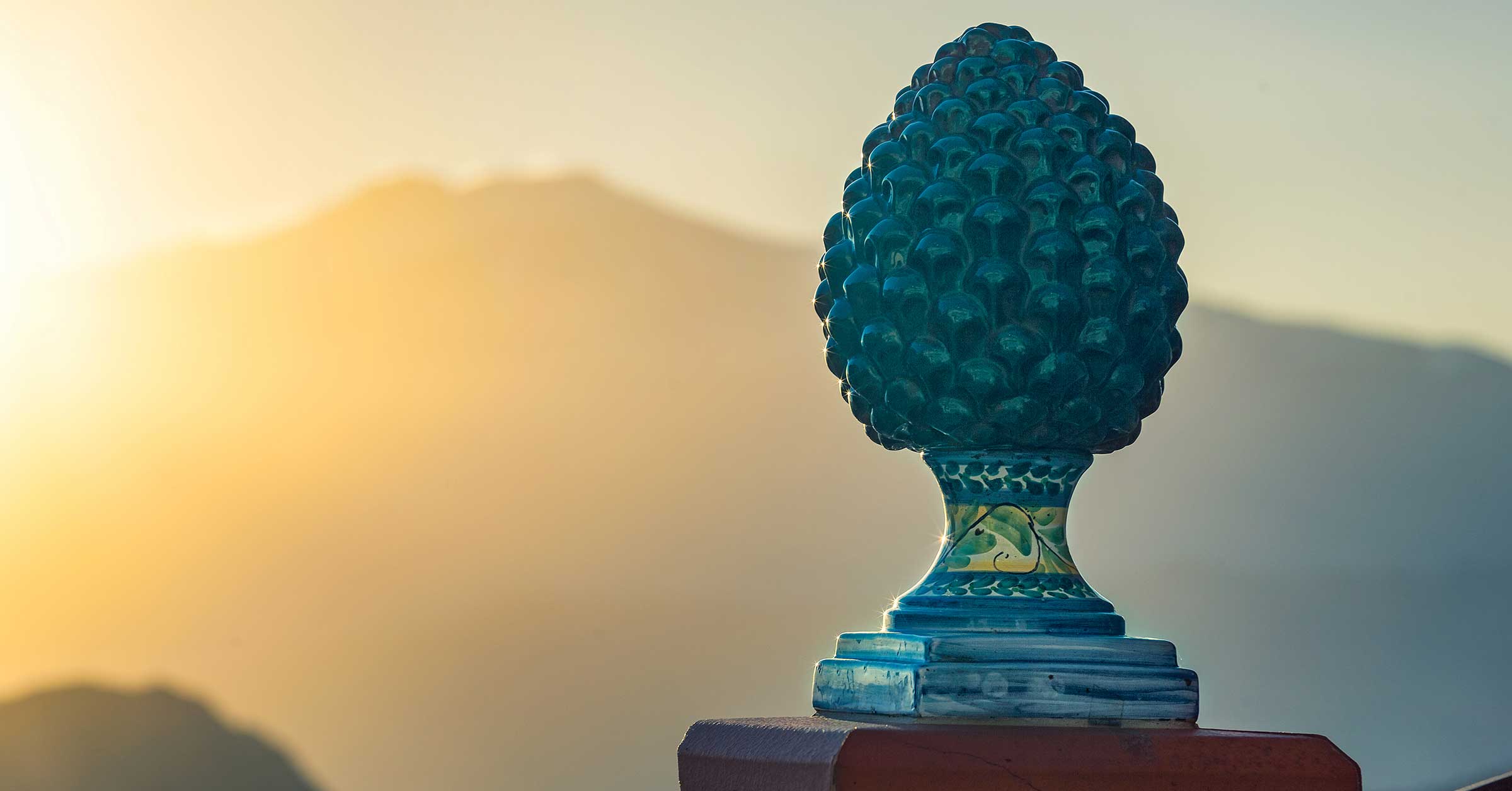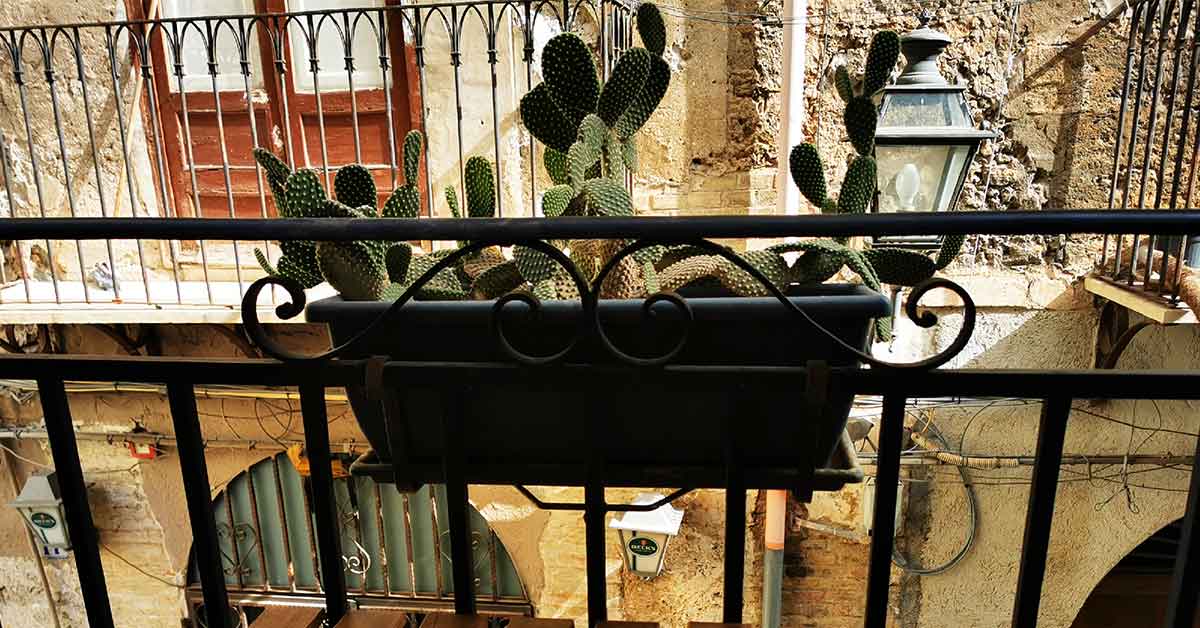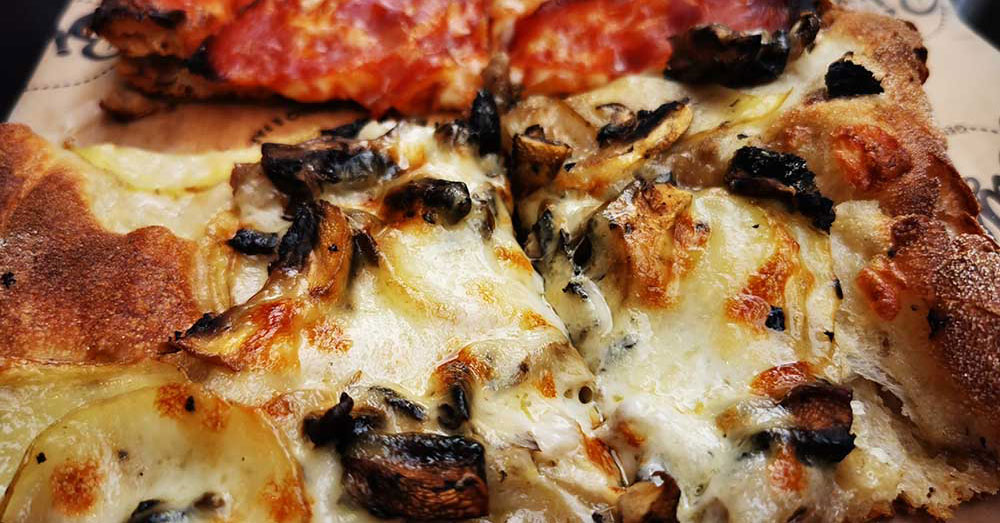What to See in Palermo & The Mysteries Behind | Ancient Palermo Architecture Guide
Wondering what to see in Palermo, Sicily, in terms of ancient architecture? From Norman cathedrals to beautifully decorated Baroque facades, the streets of Palermo speak, layer by layer, so much of its complicated past—Arab, Byzantine, Spanish, and Italian influences are all gathered in this magical city.
Our travel guide covers some of the most beautiful buildings and most visited attractions, only historical places in Palermo, and the stories behind the way they look today.
Palermo, the fairy-tale city located on the Italian island of Sicily, is a must visit destination, especially in the summer.
Its history dates back over 2,700 years, and has been home to many different cultures throughout the centuries. In terms of things to see, Palermo’s architecture is a must and the most vivid reflection of its rich and diverse history, an unusual blend shaped by an almost endless succession of conquerors bringing in their cultures.
The city’s location along the Tyrrhenian Sea, an arm of the Mediterranean, has always made it an important spot for naval and trade activities.
Having a strategic location meant that many powers, including the Greeks, Romans, Byzantines, Arabs, Normans, and Spaniards, wanted and eventually controlled Palermo over time. Each left their mark on the city, making it a unique place with a mix of architectural styles, layered one upon each other.
Disclosure: This article contains affiliate links. If you make a purchase after clicking one of these links, I earn a small commission from that website at no extra cost to you. Learn more: Disclosure policy.
 Palermo Architecture Styles
Palermo Architecture Styles
Palermo’s earliest architectural influences date back to the Phoenicians and Greeks. While much of this has been overshadowed by later structures, some remnants of Greek architecture can be seen in nearby archaeological sites. With the Roman rule (3rd-4th century AD), came also the introduction of their classic architecture mastery, sturdy engineering and use of concrete, arches, and intricate mosaics, particularly in villas and public buildings.
Subsequently, after the fall of Roman Empire, during the Byzantine era (5th-9th Century AD), Palermo witnessed a shift towards ecclesiastical architecture, Greek-cross-plan churches, domed roofs, and some of the most intricate mosaics the world had ever seen.
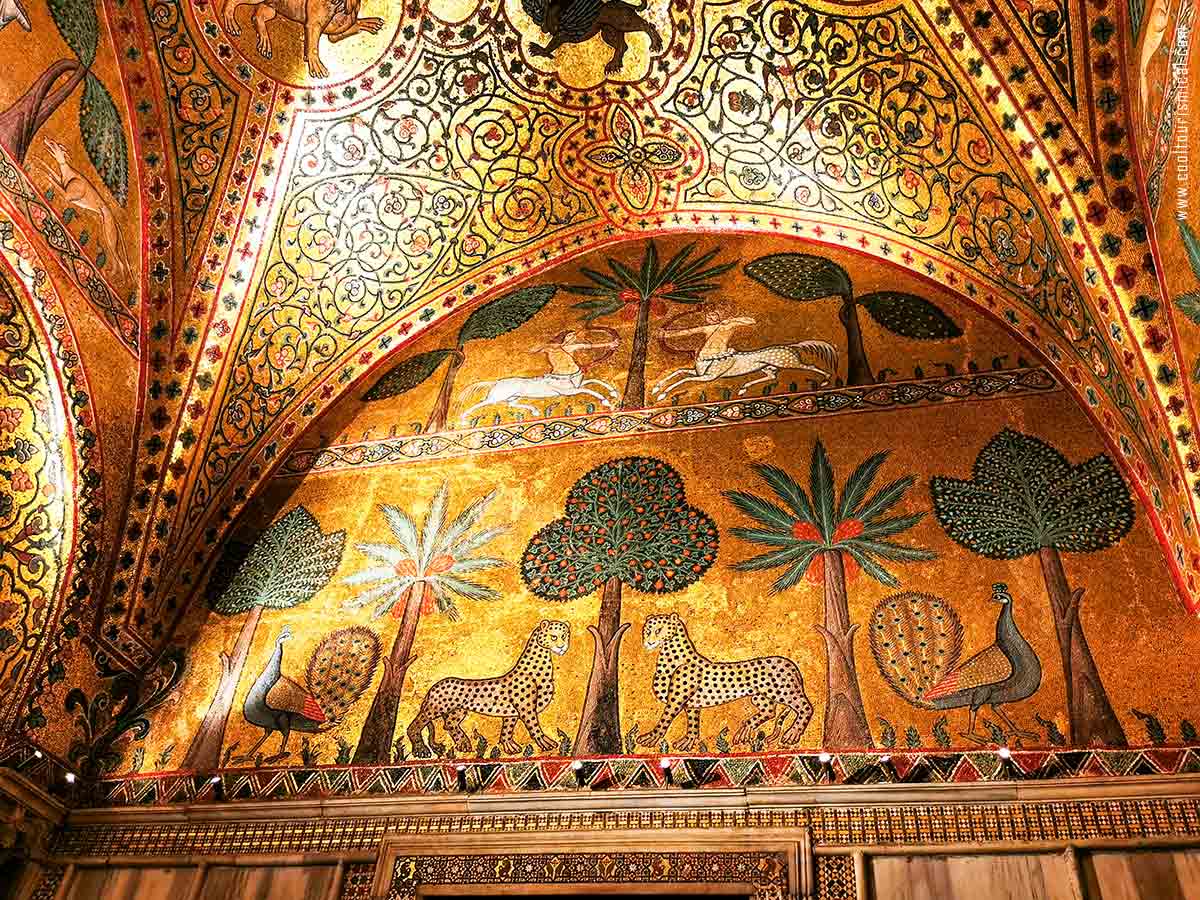
The Palatine Chapel – Byzantine Mosaic, Copyright © Cooltourismical.com
Later on, beginning with the 9th century, the Arabs introduced a completely distinct culture and architecture. Moorish architecture was characterized North-African elements such as horseshoe arches, decorative tilework, red domes, Islamic inscriptions, wooden muqarnas handing from ceiling, and lush gardens.
The Arab rule resulted in magnificent palaces, gardens, and public buildings, as well as the transformation of the city in one of the most powerful centres for commerce. Their influence is notably seen in the layout of the city, with narrow, winding streets and ancient open-air marketplaces.
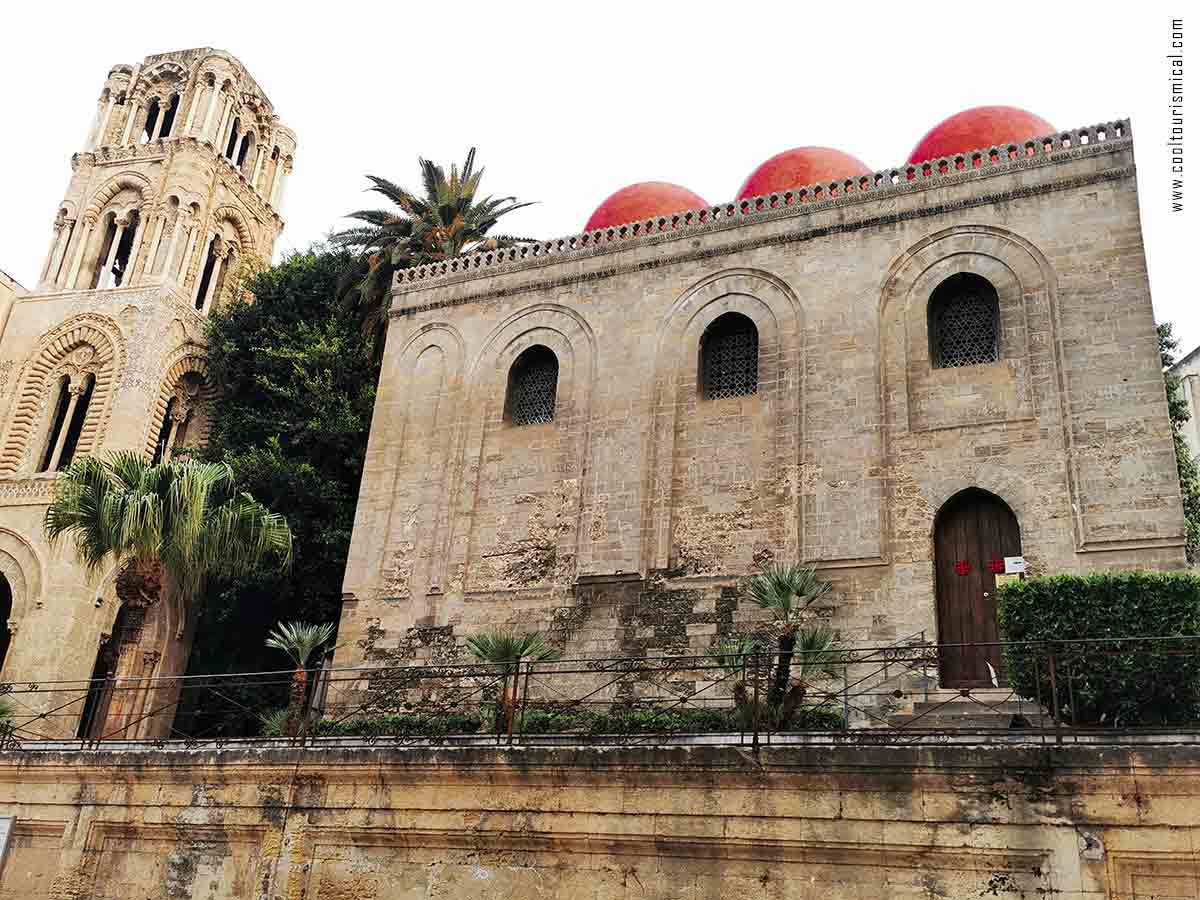
San Cataldo – red domes and Arab-style merlons, Copyright © Cooltourismical.com
But it was the Norman conquest in the 11th century that made Palermo architecture reach its full potential.
The Normans skilfully integrated the best of what they found in the city with Nordic culture. They fused their Gothic-inspired European Romanesque style with preceding Arab and Byzantine elements. The most striking features of Norman influence were the pronounced vertical elements added to existing structures, such as towers flanking the façades, combined with domes, intricate arches, and courtyards reminiscent of Islamic architecture. Many were set within traditional Byzantine layouts and keeping their famous mosaics.
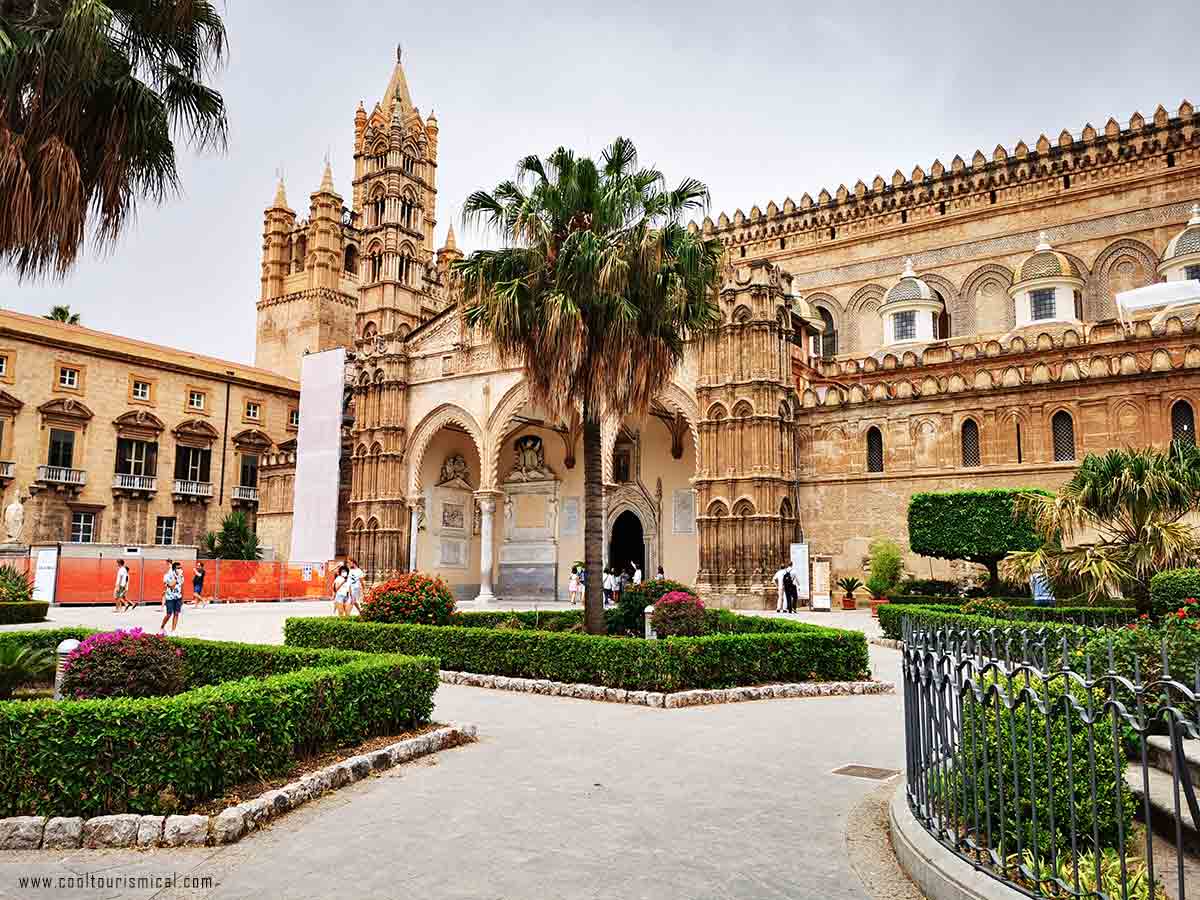
Arab-Norman Cathedral in Palermo, Copyright © Cooltourismical.com
This is how the extraordinary Arab-Norman Style came to life and it developed from the 11th century until the 13th. Many of the historical buildings of that time have internal courtyards (patios) and loggias (covered galleries), offering shelter from the Sicilian sun.
Spanish rule (13-15th century) introduced Renaissance and later Baroque styles, as well as the Catalonian Gothic, so obvious in grand public buildings, palaces, and churches. These styles are marked by dramatic, ornate, and theatrical designs, with a strong focus on visual effect. Palermo experienced significant redevelopment in the Baroque and Rococo styles during the Spanish rule. This is evident in the ornate facades, grand staircases, elaborate balconies, and intricate stucco decorations found on many buildings.
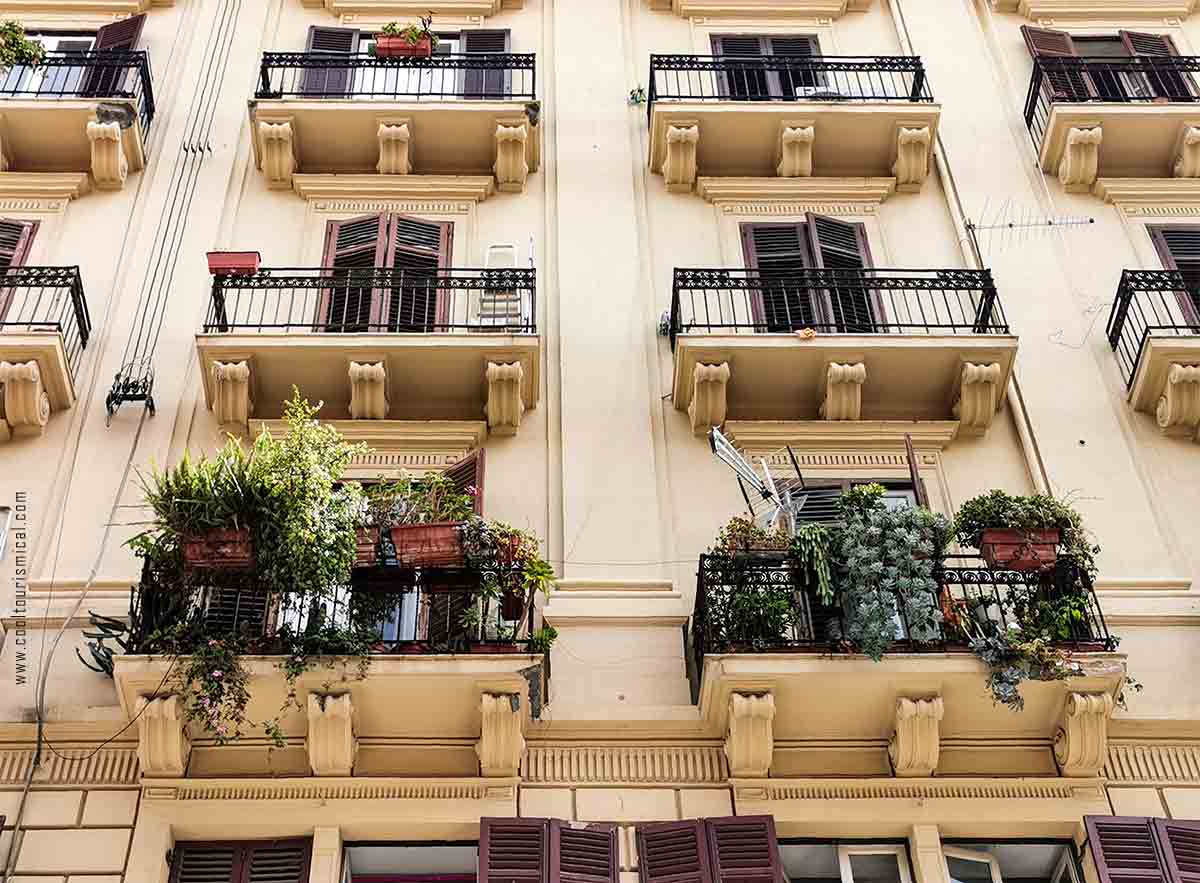
“Belle Epoque” building on Via Gorizia in Kalsa district, Copyright © Cooltourismical.com
In the late 19th and early 20th centuries, Palermo embraced the grandeur of Art Nouveau (locally known as Stile Liberty). This style is characterized by organic, flowing lines and forms, often inspired by natural elements. It’s still visible in decorative details like wrought iron balconies, ornamental friezes, and stained glass.
Its vibrant past has packed Palermo with so many things to see and enjoy. That includes historically significant tourist attractions like palaces, villas, churches and ancient markets. It is also one of the main reasons why Palermo is worth visiting.
🏺
Phoenician & Greek foundations
🏛
Roman influences: baths, columns, mosaics
⛪
Byzantine & Arab periods: domes, courtyards
🏰
Norman-Arab fusion: arches, gardens, golden mosaics
🎭
Baroque & Neoclassical flourishes
 Top 10 Things to See in Palermo
Top 10 Things to See in Palermo
Some of the most amazing buildings in Palermo (tourist attractions map) extend to tens of ancient structures from medieval and baroque churches to Arab-Norman palaces and neoclassical villas, grouped along narrow, winding streets, around old Arab markets, large piazzas, and sometimes surrounded by these exotic green spaces. All magical!
That is why choosing only 10 must-visit places in Palermo, Sicily is so hard. But I can try. Below, my favourite ones.
Palazzo dei Normanni & The Palatine Chapel
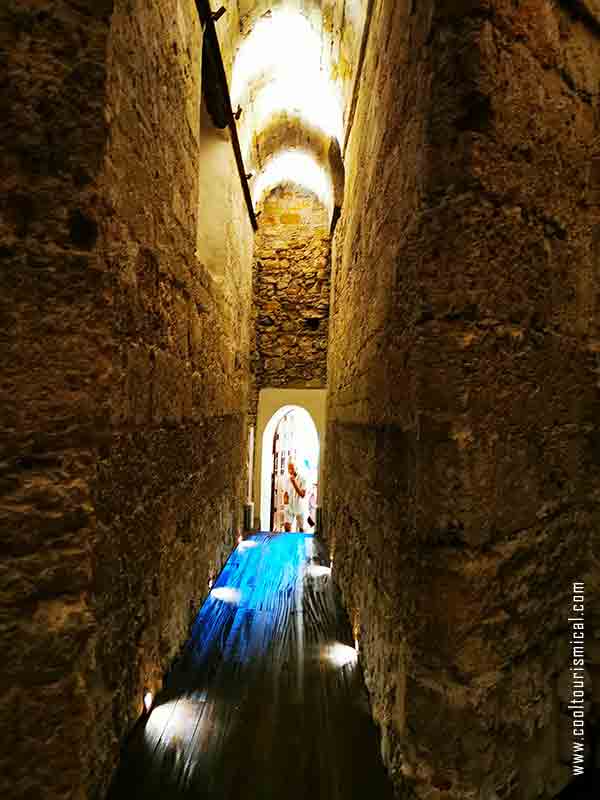
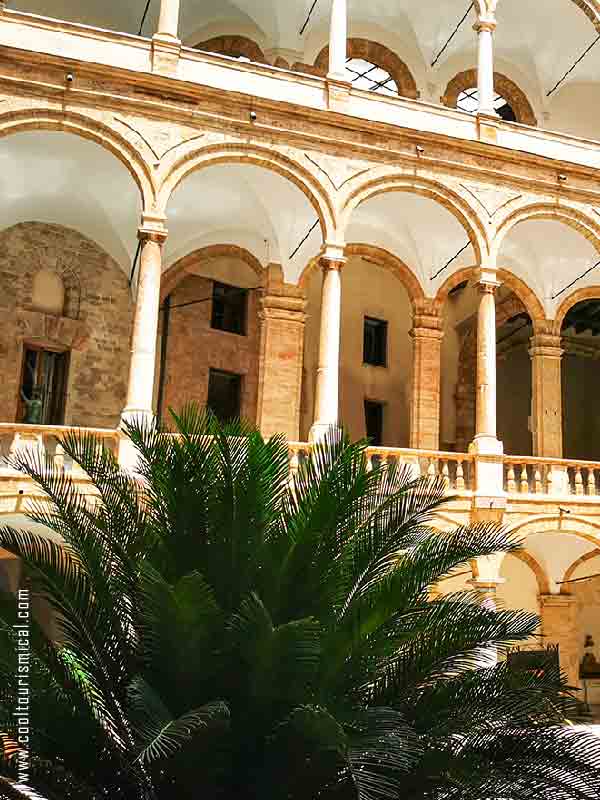
Palazzo dei Normanni, Copyright © Cooltourismical.com
One of Palermo’s most renowned historical landmarks is the Norman Palace, or Palazzo dei Normanni as locals call it. The palace is a symbol for the multicultural history, merging in its architecture and interiors Arab, Norman, and Byzantine influences.
Originally built in the 9th century by the Arabs, it was later expanded by the Normans in the 12th century.
It’s a rare beauty, especially when speaking about its Palatine Chapel. Added in 1132, the Chapel is a masterpiece of Byzantine art, mostly due to its intricate mosaics rivalling even those found in Constantinople. But strangely enough, the chapel is also known for its wooden ceiling with Islamic-style muqarnas, an extremely unusual element to be found in a Christian structure.
Palermo Cathedral (Cattedrale di Palermo)
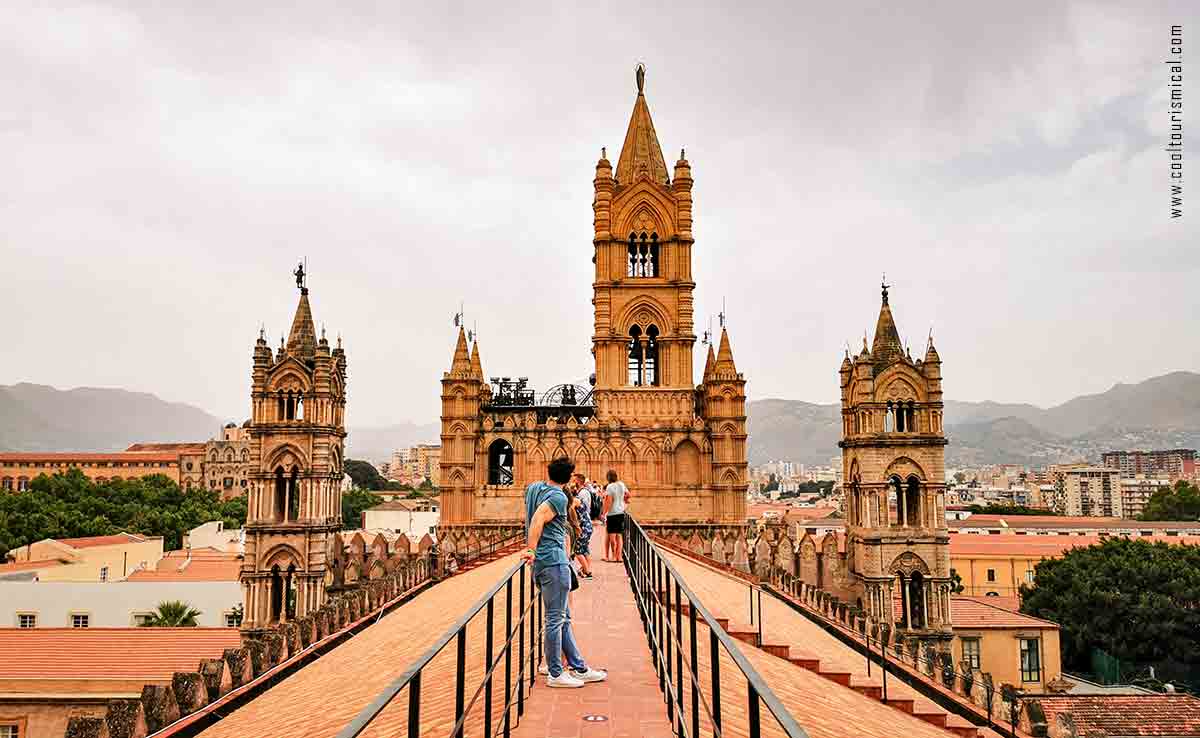
Palermo Cathedral Rooftop, Copyright © Cooltourismical.com
Another architectural marvel in Palermo is its Cathedral, with its very own historical layers. Established in 1185, the Cathedral has undergone numerous transformations, reflecting various influences from the Norman, Moorish, Gothic, Baroque, and Neoclassical styles. Gothic towers, Arabic-style arches, majolica cupolas and 18th-century Baroque makeover of the interior.
During the 12th century construction, the Normans had repurposed it as a Christian church on the location of a former 9th-century mosque, which itself had been built on the site of an even earlier Christian place of worship.
The Cathedral houses royal tombs and the jewel-encrusted crown of Constance of Aragon, as well as a treasury with precious ecclesiastical relics.
But the best part of visiting the cathedral is being able to climb the roof. The ridge of the roof supports a large walkway, flanked by towers, from where you can see the whole Albergheria district.
Teatro Massimo
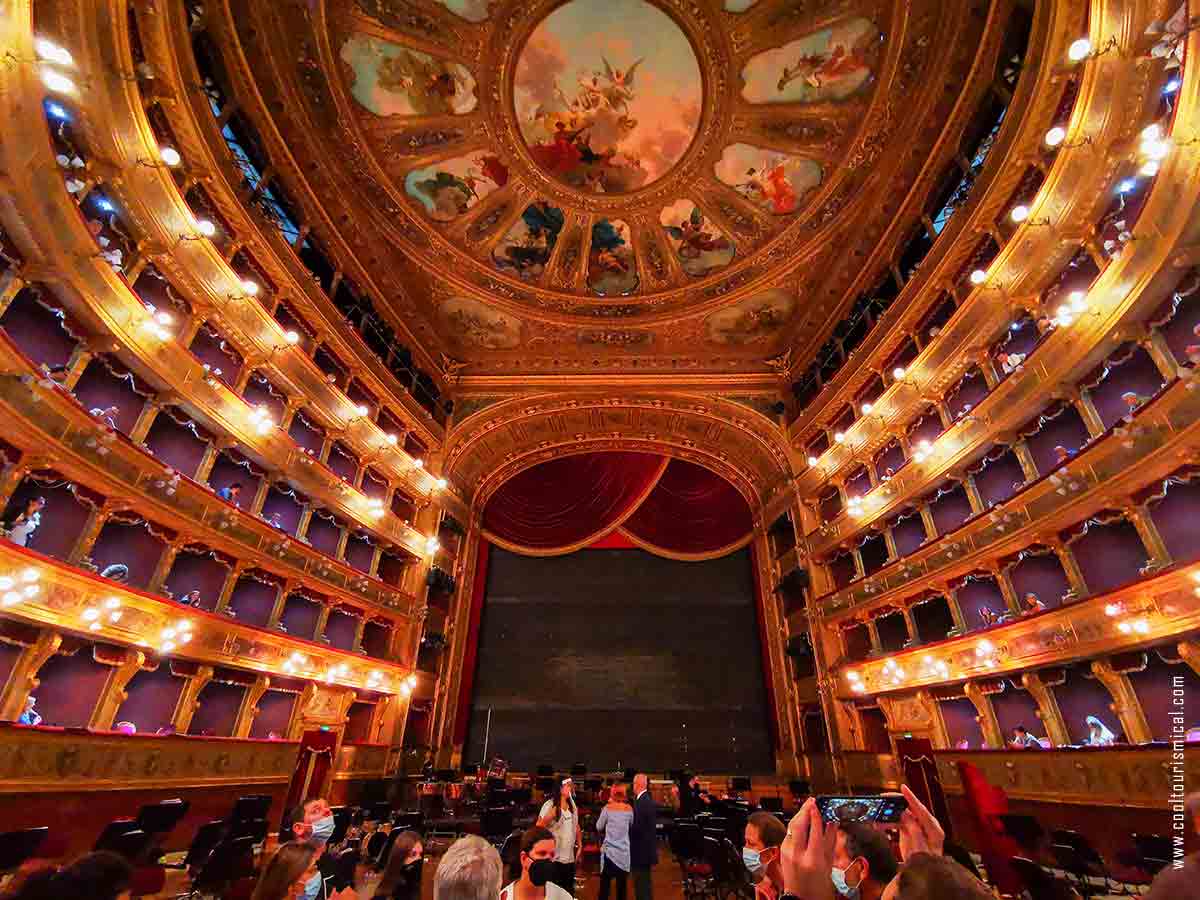
Teatro Massimo Horseshoe-Shaped Auditorium, Copyright © Cooltourismical.com
Teatro Massimo is a spectacular neoclassical theatre from the 19th century, that ranks among Europe’s largest opera houses. And it’s really worth adding it on your list of must-see places in Palermo.
The theatre is one of the most famous buildings in Palermo and offers a unique behind-the-scenes tour, where you can experience first-hand a live performance, marvel at the auditorium’s impeccable acoustics, and wander through its magnificent hallways decorated with red carpets and giant, smoky mirrors. Even more exciting is the fact that the locals think the theatre is haunted by a nun who’s tomb was disturbed during the construction. There’s also a mysterious “step of the nun” within the theatre, notorious for tripping those who doubt the haunting tale. Would you dare to doubt?
Orto Botanico
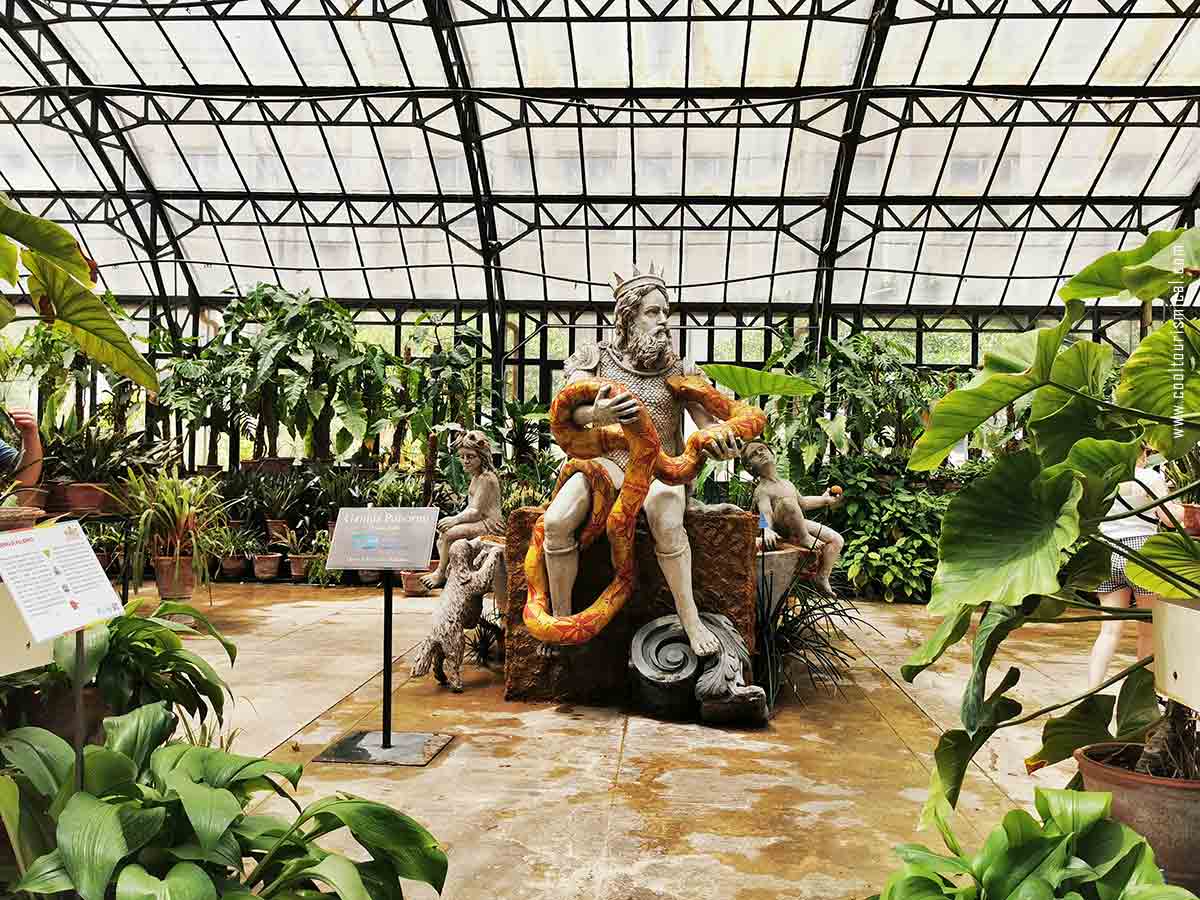
Il Genio di Palermo at Orto Botanico, Copyright © Cooltourismical.com
Palermo’s parks and gardens have been famous for centuries now, but the most amazing of all is Orto Botanico, This is one place you must visit!
Palermo’s renowned botanical garden’s origins can be traced back to 1779, initially established for the cultivation of medicinal plants by the Accademia dei Regi Studi. The site had been orchards belonging to the former villa Giulia. The current villa Giulia is a park with giant trees and neo-Pompeian pavilions, attached to Orto Botanico, but separated.
The main buildings inside Orto Botanico are neoclassical, while the greenhouses, completed in 1823, were a gift from Queen Maria Carolina of Austria. Originally constructed of wood and heated by stoves, they underwent a complete reconstruction in the second half of the 19th century, being rebuilt using cast iron. The glasshouses host exotic plants and some amazing statues like the one of Palermo Genius.
Palazzo Chiaramonte-Steri
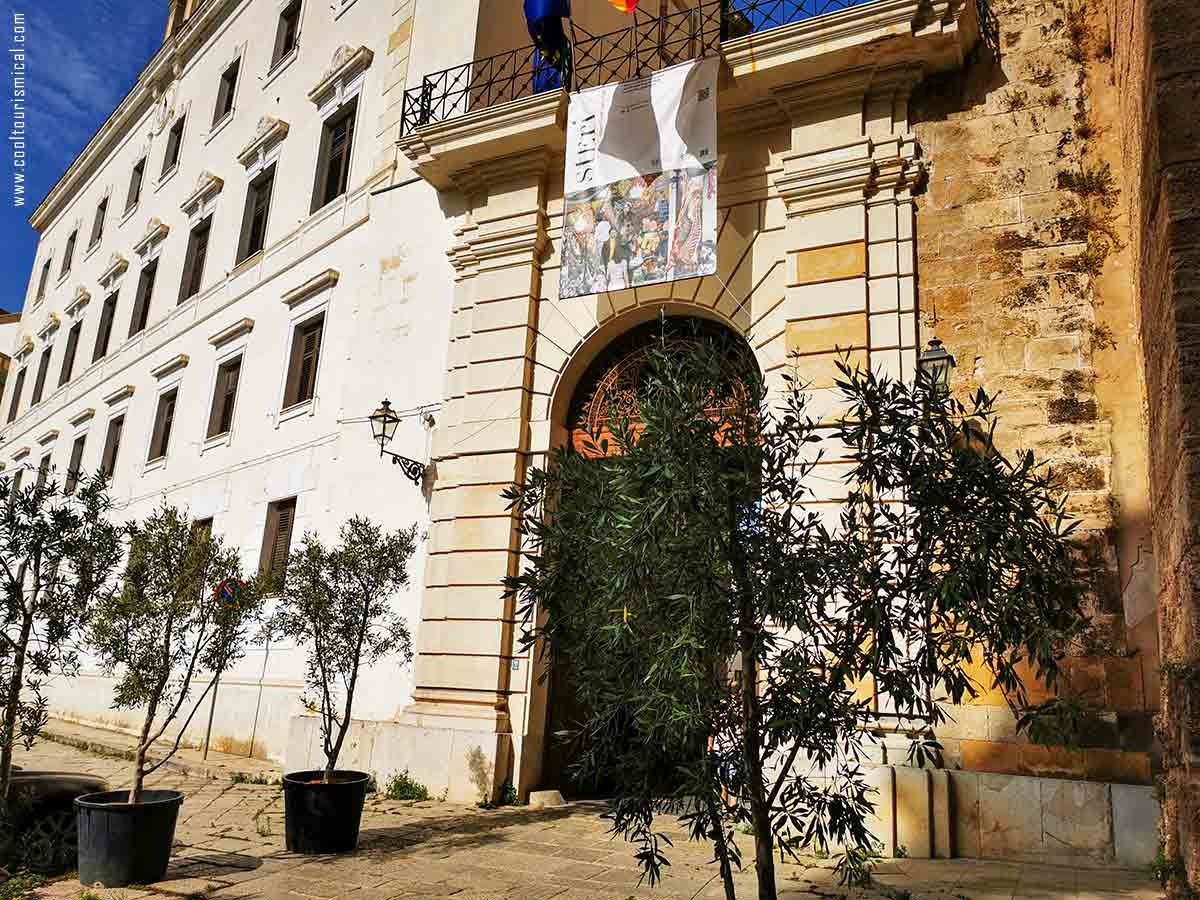
Palazzo Chiaramonte Steri Palermo Main Access, Copyright © Cooltourismical.com
When you reach Kalsa district, Palazzo Chiaramonte-Steri is the landmark that stands out.
Built in the 14th century for the powerful Chiaramonte family, the palace served for various purposes along the ages, from noble residence to seat of the Spanish Inquisition, prison and, eventually, cultural hub and museum. The architecture features pointed arches and robust stone walls, characteristic of its Romanesque-Gothic style, known locally as the Chiaramonte Gothic.
Inside, the Palazzo Chiaramonte-Steri has an impressive hall, “Sala Magna,” renowned for its impressive wooden ceiling, intricately painted with scenes depicting historical and mythological narratives.
Santa Maria dello Spasimo
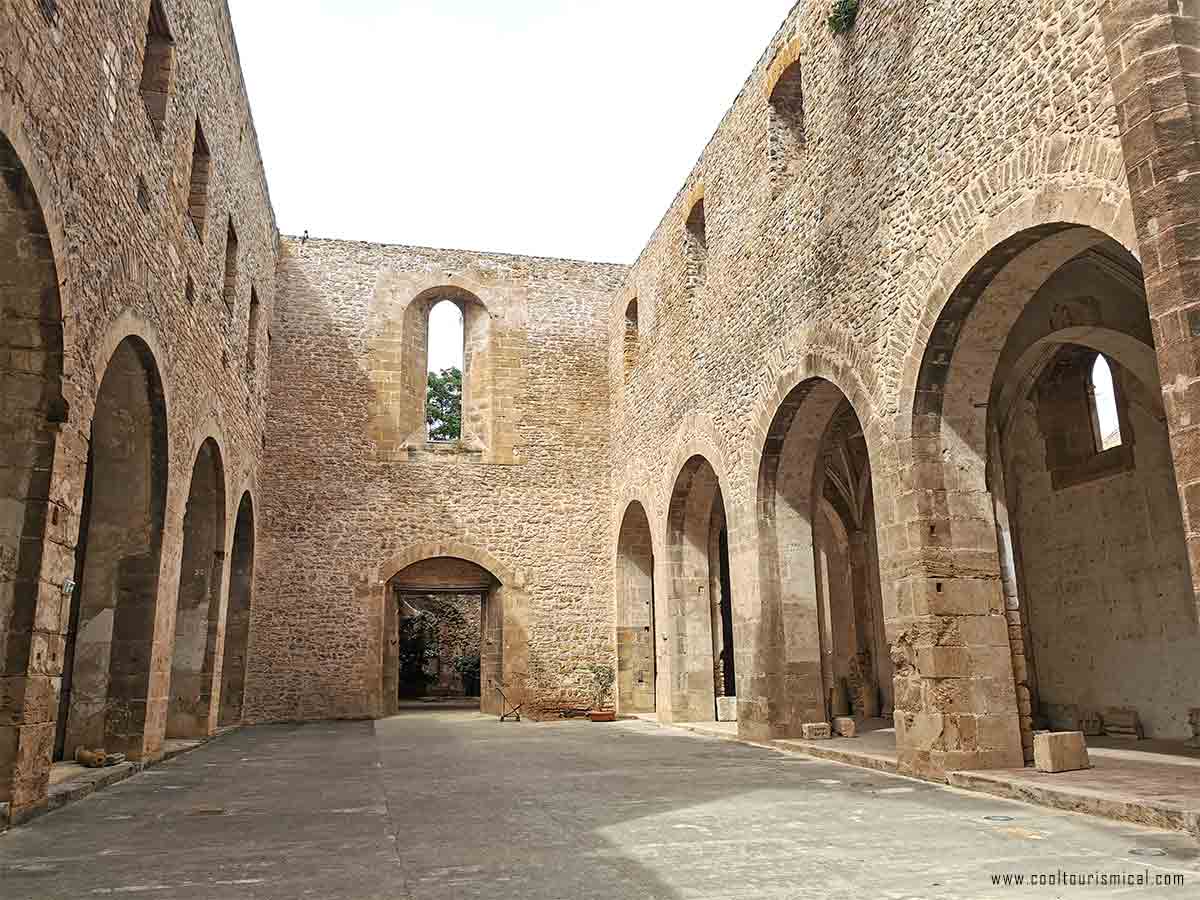
Santa Maria dello Spasimo Complex, Copyright © Cooltourismical.com
And you can’t leave the historic Kalsa without seeing the monumental Santa Maria dello Spasimo Complex – a 16th century, Gothic-style, never finished Catholic church. Due to the many foreign invasions, the city resources were always redirected into fortifications. In this way, the church never got a roof.
But even so is was used as an unique frame for plenty of functions along the years: from church to theatre to hospice for the poor and hospital during an epidemic. After the Second World War, it was a storage place for works of art. And then, back again to an open air space for artistic performances, such as the Palermo’s Jazz Festival, hosting legends like Miles Davis or Frank Sinatra right under the stars.
Palazzo Mirto
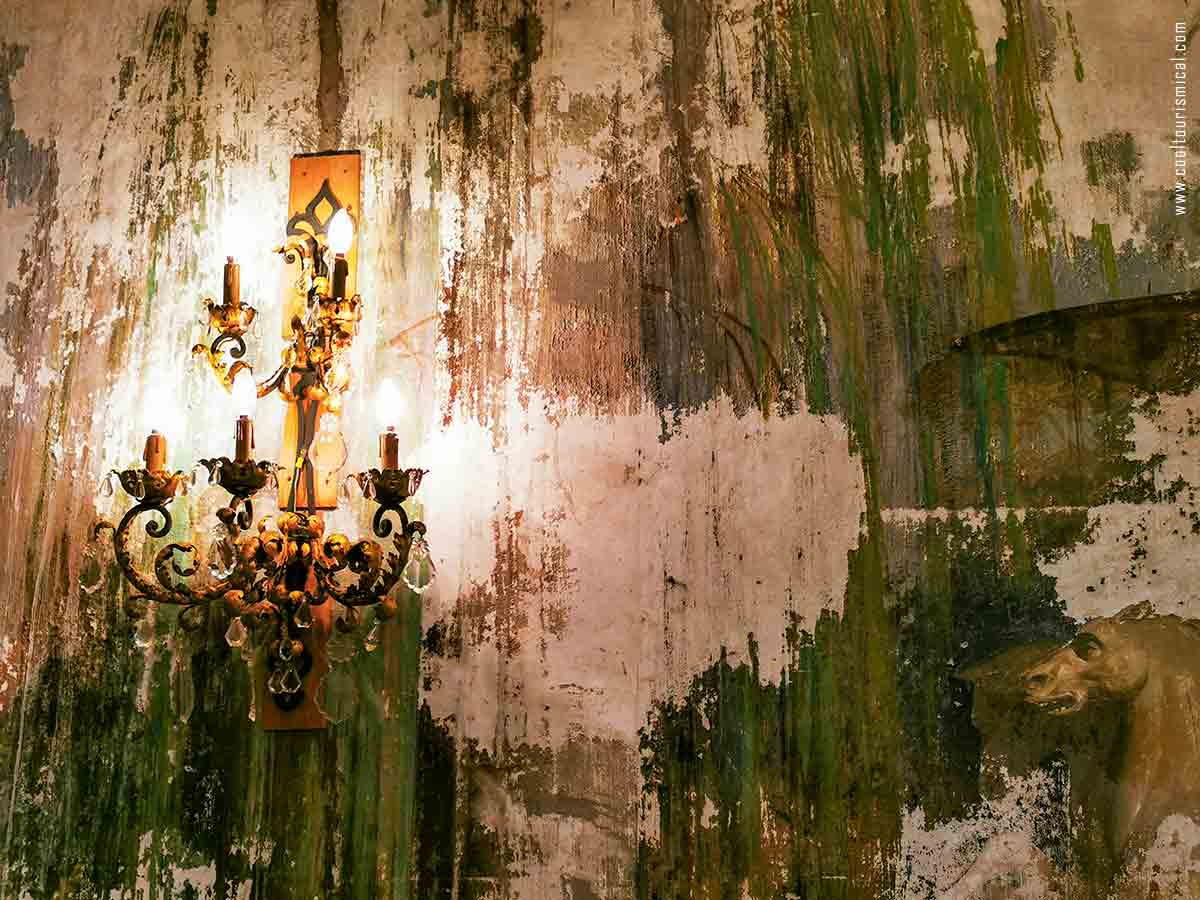
Palazzo Mirto – Wall Detail, Copyright © Cooltourismical.com
In the nearby Albergheria district, Palazzo Filangeri, known also as Palazzo Mirto Casa Museo, is a Baroque-style aristocratic palace of the 17th century.
The palace is not big, but it’s a time machine for how the Sicilian nobles lived back in the day. The palace really feels like an old family home. It’s filled with with lots of antiques, old furniture still in place, walls covered in silk and velvet paper, floors paved with majolica tiles and mosaics, all in dim light of the overwhelming chandeliers. And despite being a little worn off, it keeps its amazing opulence and mystery with elegant lounges, secret passages, old smoking rooms, and a marvellous stable.
It is by far my favourite place in Palermo.
Quatro Canti & Fontana Pretoria
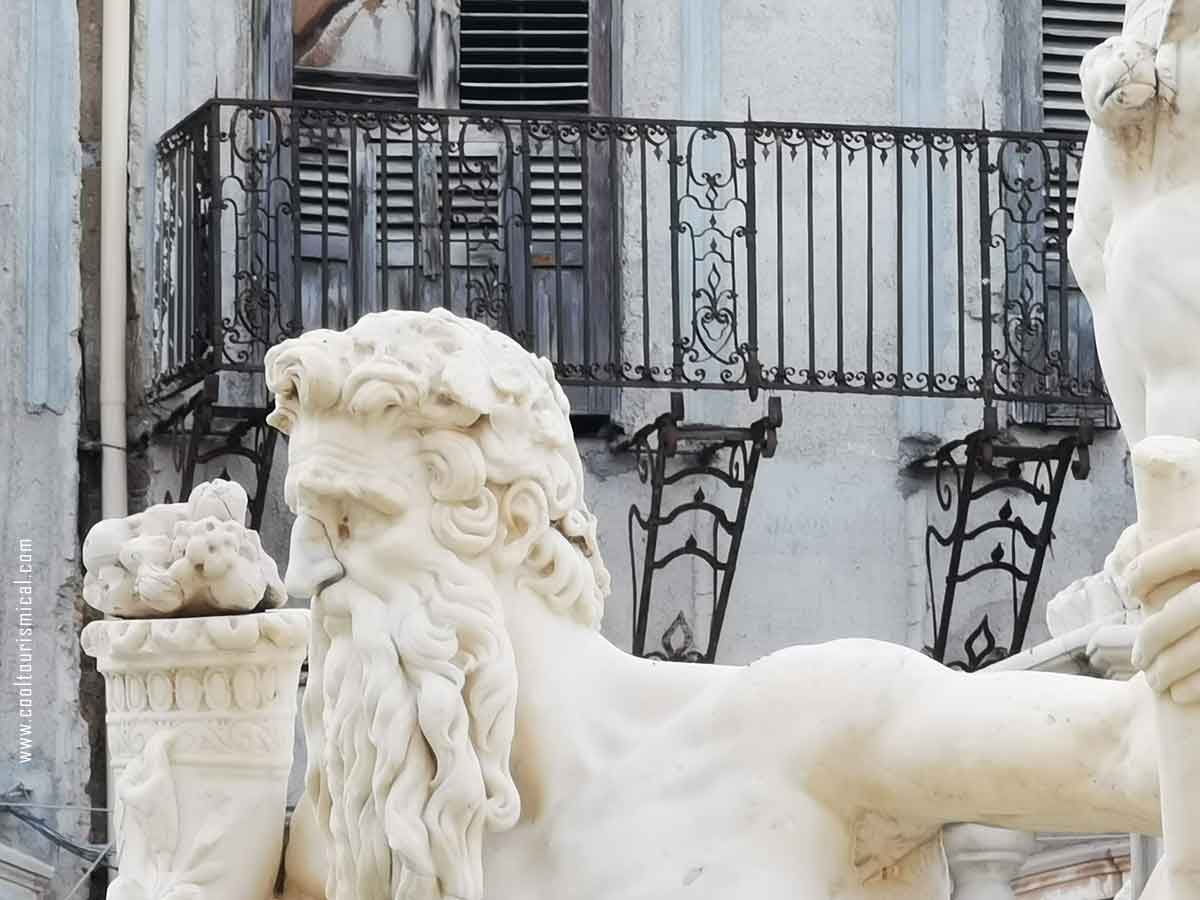
Fontana Pretoria, Copyright © Cooltourismical.com
Quattro Canti is the famous intersection of the city’s two main streets, Via Maqueda and Corso Vittorio Emanuele, dividing Palermo’s center into four historical districts. This iconic crossroads has at each of its four corners a façade representing one of the four seasons, along with statues of Spanish kings and patron saints of the old quarters of Palermo.
Behind the Winter statue corner is the Fontana Pretoria, also known as the “Fountain of Shame“, because of the nudity of its Carrara marble statues. Mythological figures and animals are all centered around a grand basin and surrounded by Renaissance, Baroque and Rococo buildings. This magnificent fountain is a masterpiece of Renaissance art and a major landmark in Palermo. It was originally designed for a Tuscan villa, but was installed in the end in Palermo in the 16th century.
Vucciria Market
This, along with the other ancient markets of Palermo, is one of the city’s most vibrant spots, echoing the busy markets of North Africa and the Middle East. Here, Sicilians buy and sell almost everything, from unusual spices and fruits to fish and handmade crafts. (Recommended read: Palermo souvenirs). Even if you don’t necessarily want to buy something, it’s still worth seeing.
Reminiscent of a traditional Arab souk, Vucciria unwraps along narrow, winding alleys. The streets are surrounded by continuous rows of four-story buildings with bright façades, often painted in warm shades of yellow, red, and orange At the ground floor, shops and stalls line up.
The area includes a blend of architectural styles from different times, ranging from medieval to modern. Many of the existing buildings would have been built or significantly modified during the Spanish rule of Sicily (16th -18th century). This means that some of the houses and structures in the area could be several hundred years old, although they may have undergone renovations and restorations over time.
Small, intricate metal balconies hang on façades that are mostly solid and often adorned with exposed stone. Sometimes, the buildings incorporate even elements from the city’s older structures.
The Capuchin Catacombs
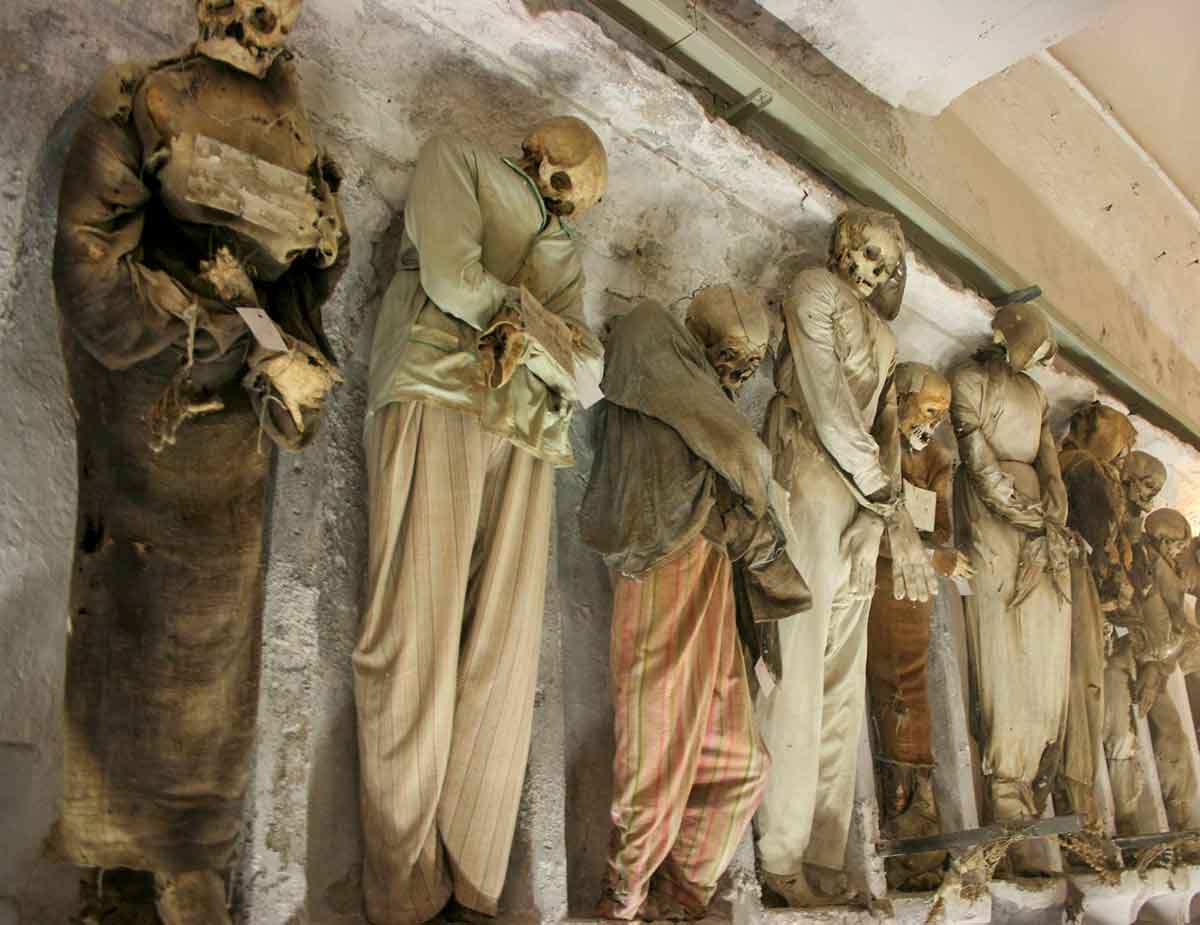
Catacombe dei Cappuccini, Copyright © Juan Antonio Segal | FLICKR, used under CC BY 2.0
This is one of Palermo’s most unusual and eerie sites, both an example of subterranean architecture and burial rituals of the time. Here, in the underground corridors, rows of mummified bodies including monks, professionals, and even children, are methodically arranged according to their social status and profession. Displayed in niches or in open coffins, they are the force of a macabre gallery-like atmosphere.
Originating in the late 16th century as a burial site for Capuchin monks, the catacombs expanded to accommodate the broader Catholic community. During this time, Sicily was experiencing with the Baroque in art and architecture. The catacombs, in their own way, mirror this artistic sensibility of the era and the fascination with death.
Organized Tours for Exploring Palermo’s Landmarks
Some people like exploring by themselves, while some others prefer having a local guide to introduce them to all those tiny things we can’t see or find out on our own. You know, the small secrets and genuine feelings and experience behind a building, a sculpture or a tasty dish.
Are you in the second category? In that case, I do recommend taking a tour. The ones below are the best in Palermo.
 Best Palermo Palaces to Visit
Best Palermo Palaces to Visit
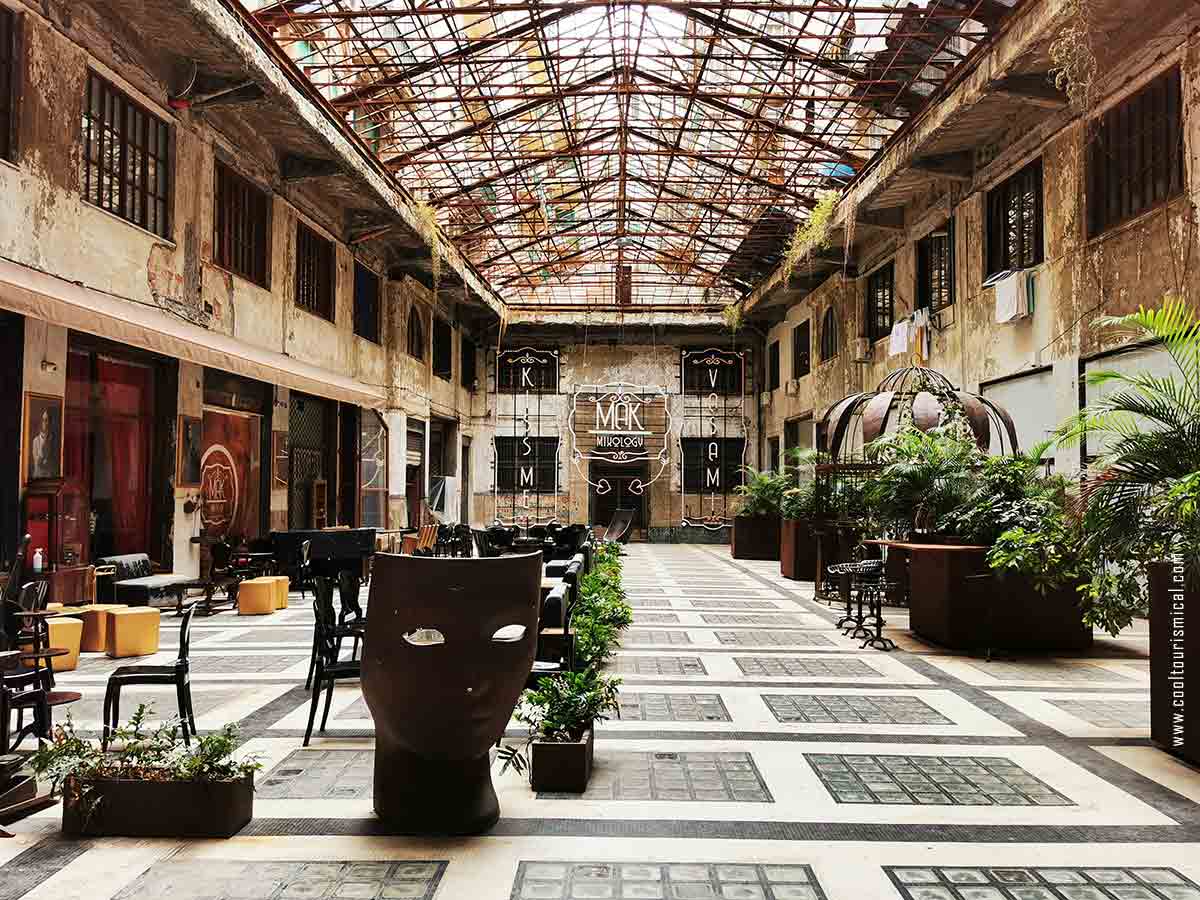
Galleria delle Vittorie, inside a 20th century palace, Via Maqueda, Copyright © Cooltourismical.com
If you like old palaces and the stories they hide, you’re in the right place. Palermo’s palatial architecture is quite fascinating, as you can find so many old nobility residences or old commercial galleries, one next to each other, each telling different stories. You’ll see a bunch of these epic buildings especially in the Kalsa and Albergheria old districts, right along Via Vittorio Emanuele, from Porta Felice to Porta Nuova.
In the ancient quarter of Kalsa, just a short distance from the magnificent Palazzo Chiaramonte-Steri lies another historical gem, Palazzo Butera. This 18th-century Baroque-style aristocratic palace faces the Mediterranean and its wide terrace overlook a promenade atop former defensive city walls, known as Passeggiata delle Cattive.
Nearby Palazzo Abatellis, at less than 3 minutes distance from the other two is a 15th century Catalan Gothic palace and former monastery, housing a gallery with mostly religious works, wood sculptures & Renaissance paintings. A bit further away, Palazzo Forcella De Seta, once an aristocratic seaside home, it became a 19th century example of eclectic architecture and one of the most one of the most sumptuous residences of the Palermitan Belle Époque: Moorish style interiors inspired by the Alhambra, reproductions of mosaics from the Arab-Norman royal palaces and a neoclassic hall.
And we are talking about tens of palaces like that.
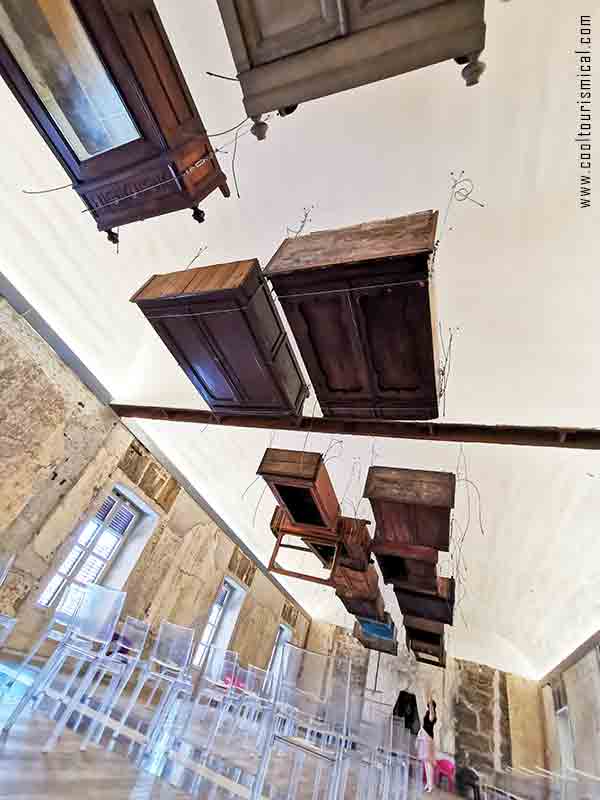
Exhibition inside Palazzo Rizo, Copyright © Cooltourismical.com
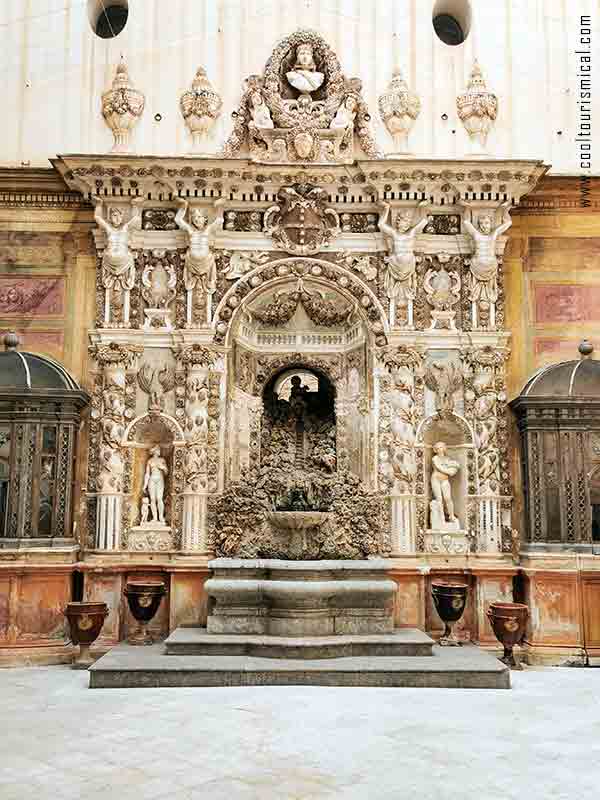
Interior Courtyard at Palazzo Mirto, Copyright © Cooltourismical.com
Palazzo Denti di Pirajno (Kalsa) hosts one famous exhibition of Sicilian Majolica, and Palazzo Riso (Via Vittorio Emanuele), lovely contemporary art pieces. Palazzo Sclafani (next to rhe Norman Palace) is the headquarters of the Army Regional Command, while Museo Palazzo Branciforte has in display of the oldest Palermitan “Pupi” marionettes belonging to Cuticchio Theatre family. Other suggestions for palaces to visit, you can find on: Palermo Things to See Map.
Highlight: Conte Federico
And this is actually probably one of the most amazing of them all.
One of the oldest buildings in Palermo. A simple façade, austere, like the one of a closed medieval stronghold greets the visitors. Few windows and delicate iron balconies. Nothing overly extravagant from the outside. Still, when you enter, you’ll be able to walk through a home that’s been layered up since the 12th century. The residence has been built around one one of Palermo’s initial Arab-Norman defence towers.
The interiors are fascinating, from medieval-like rooms, with carved stone walls and knights in metal armour, and extending to Baroque-style rooms with high ceilings and 18th-century frescoes. Their backdrop is often blue or green or greyish, showcasing antique wooden furniture.
This house has been in the same family for 15 generations and it’s still being used. The family members themselves are the ones who usually conduct the tours. Moreover, the owner, count Frederico was an award-winning, Formula 1 race car driver. The old car in the interior courtyard speaks by itself.
You can go and visit. And if you like it, you might stay for a night or more. As they also have some lovely rooms to rent our in the palace.
- ⏰ Opening hours: check at the location;
- 📌 Location: Piazza Conte Federico, 2, 90134 Palermo PA, Italy, Google Maps;
- 🎟️ Tour fee: 15 euro.
 Religious Tourism Landmarks
Religious Tourism Landmarks
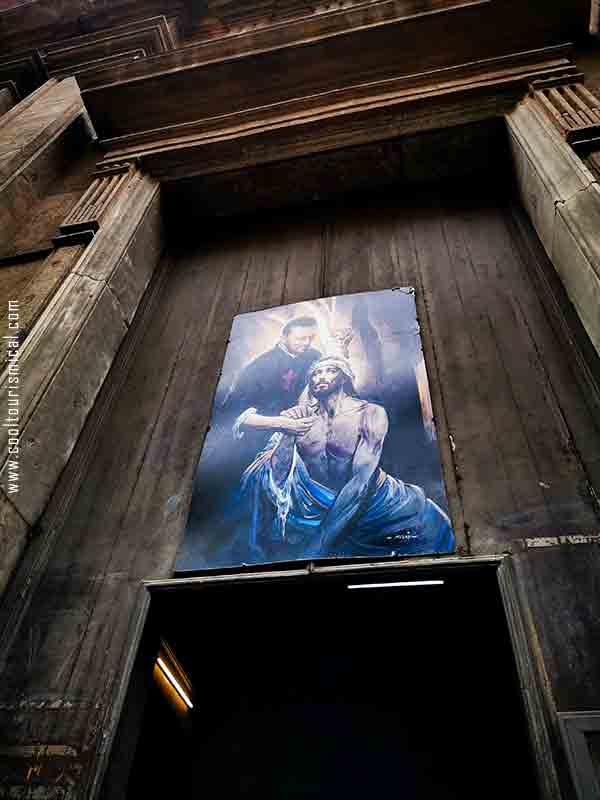
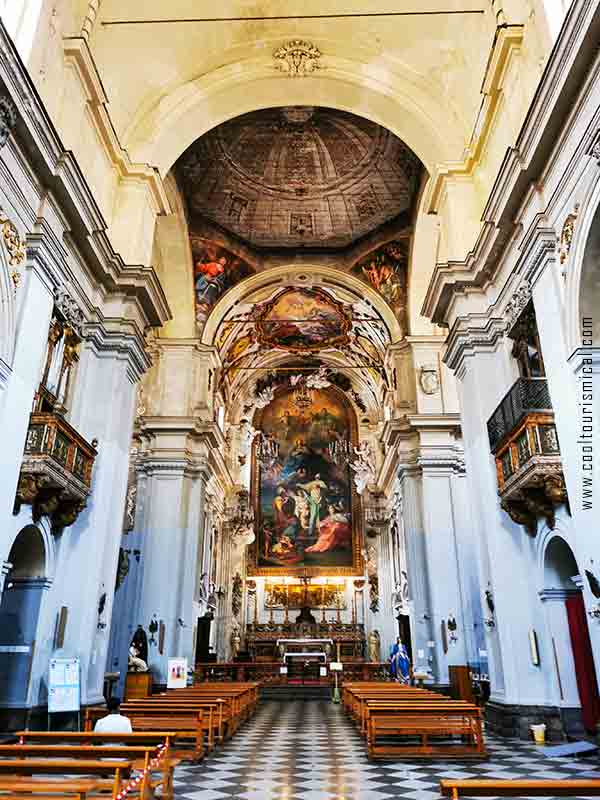
Chiesa di Santa Ninfa, Palermo, Copyright © Cooltourismical.com
Palermo is not only a city of palaces, but also one of some spectacular churches and chapels. Scattered at almost every step, the worship places can easily transform Palermo in a fantastic destination for pilgrims, particularly those interested in Christian history and heritage. In the old part of the city, I saw more than 25 churches just walking around. Most of these are Roman Catholic churches, with medieval and Baroque details.
The Palatine Chapel and The Cathedral are definitely the main religious attractions of Palermo. And, in my opinion, they are closely followed in uniqueness by the special Santa Maria dello Spasimo and La Martorana.
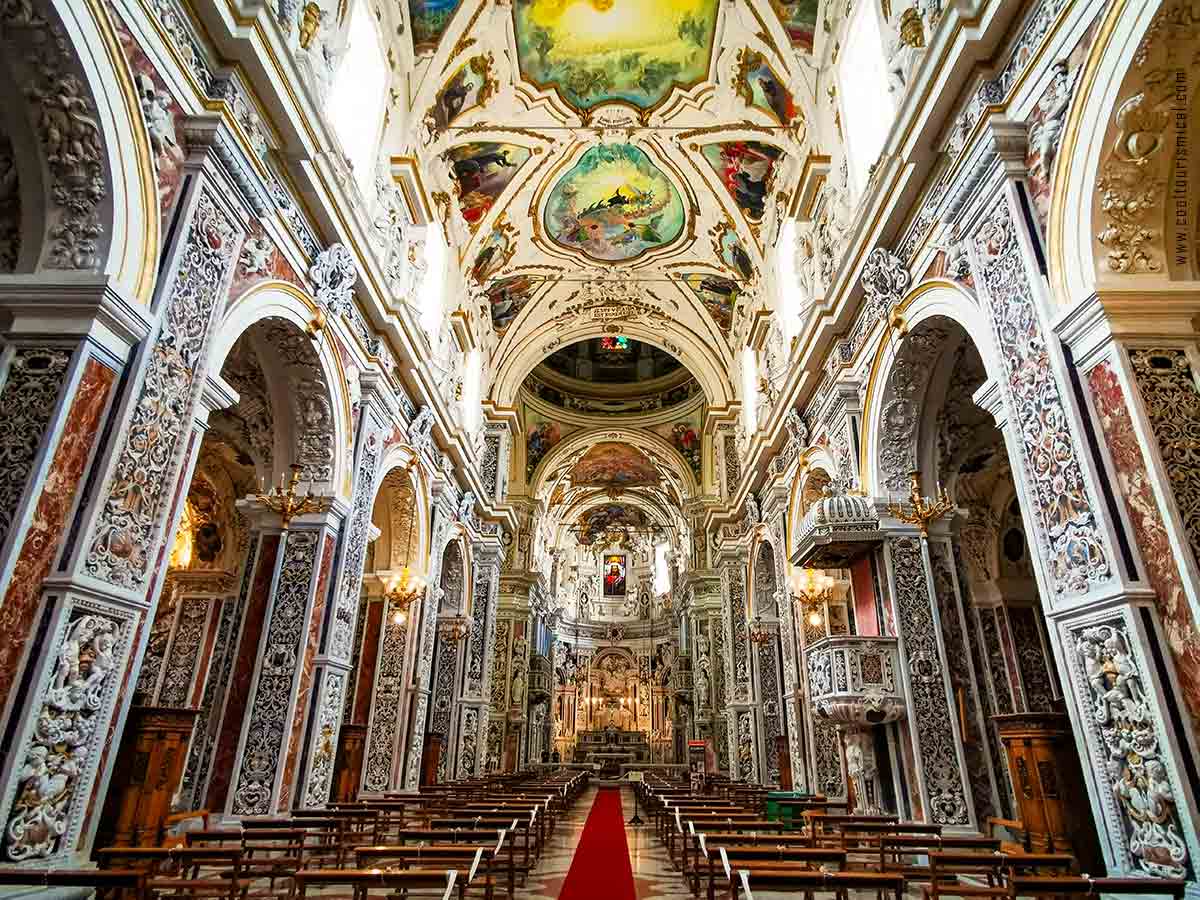
La Martorana, Copyright © Cooltourismical.com
If about the first 3 I already wrote a bit, La Martorana or Santa Maria dell’Ammiraglio is another well preserved medieval gem – a domed Norman-era church with ornate baroque remodelling known for its one-of-a-kind golden Byzantine mosaics. This church faces the Church of San Cataldo, another Arab-Norman worship place built with 3 spectacular red domes atop of its austere and sand-colour, ancient stone walls.
Next in line are Chiesa di Santa Maria della Catena, which is called St Mary of the Chains because during medieval times this church actually had a giant chain that literally locked up the city’s port and Basilica della Magione (Kalsa) with a beautiful Arab-style garden, reminding of the Andalusian Alhambra. Last, but not least, it’s the absolutely marvellous Chiesa del Gesù di Casa Professa (Albergheria), an extremely popular 17th-century, baroque-at-its-highest church with an austere façade, but intricate marble bas-relief sculptures decorating the interior.
Highlight: The Oratories
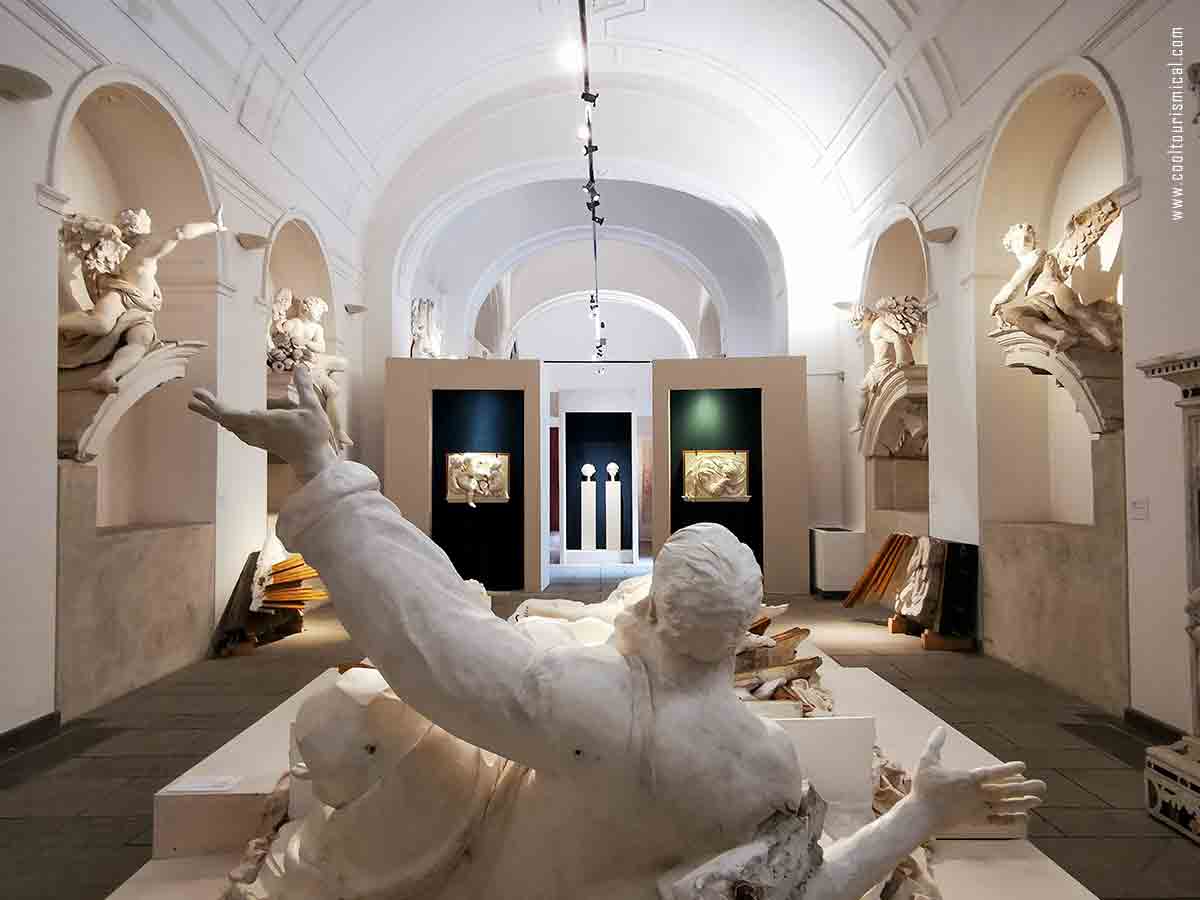
Oratorio dei Bianchi, Copyright © Cooltourismical.com
A vital part of Palermo’s cultural and religious heritage are the oratories – small chapels often associated with specific religious brotherhoods. These oratories played a significant role in the society, especially during the Baroque period. Today, the buildings are housing remarkable works of art, such as sculptures, paintings, and intricate stucco decorations.
Some of the most famous oratories in Palermo include the Oratorio di San Lorenzo, known for its magnificent Baroque interior and the lost Caravaggio painting, and the Oratorio del Rosario di Santa Cita, famous for its stunning stucco work by Giacomo Serpotta.
I only had the opportunity to explore the Oratorio dei Bianchi, historically a brotherhood focused on helping prisoners and the condemned. It’s a relatively small site. Within about 15 minutes, you can view the various stuccos and striking sculptures located on the first floor. Interestingly enough, it also houses the wooden Bab el Fotik door, famously known as the entry point for the Normans during their conquest of Palermo.
📌 More: Others, smaller, but fascinating places of worship, can be found on the Palermo Things to See Map.
 Neoclassical Villas
Neoclassical Villas
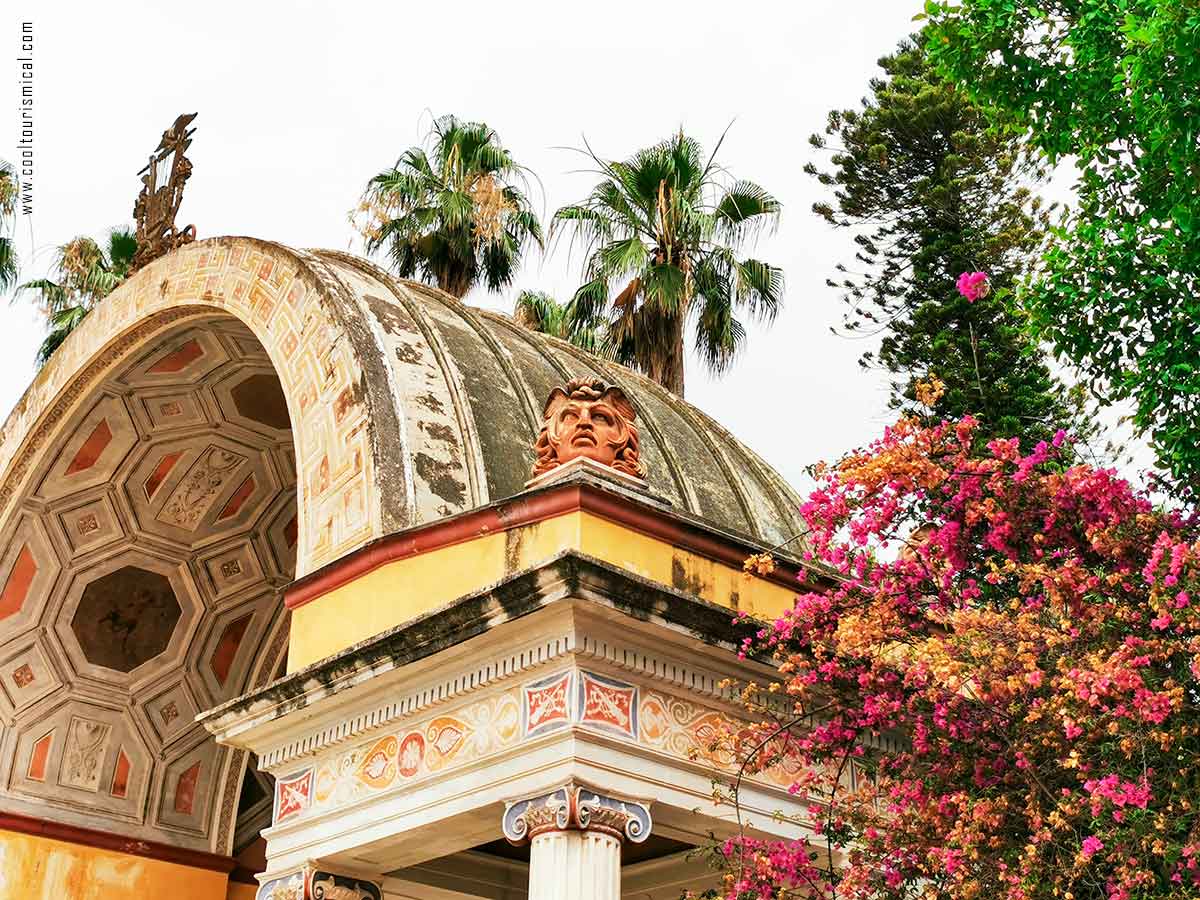
Villa Giulia Neo Pompeian Pavilions, Copyright © Cooltourismical.com
If you have enough time, you should not skip the few beautiful aristocratic mansions and their exquisite gardens, outside the old city centre.
The neoclassical villas in Palermo are a reflection of a new wave of external cultural influence, the architectural movement that swept throughout Europe following the Renaissance. And altogether a response against the flamboyant Baroque. Neoclassicism was actually being seen as a return to simplicity and symmetry with reference to the the classical art and culture of Ancient Greece and Rome.
These mansions, primarily built in the late 18th and early 19th centuries, were commissioned by the Sicilian nobility and wealthy bourgeoisie, keen on showcasing their status and wealth through the architecture of their residences.
The neoclassical influence is evident in the symmetry, balanced proportions, and harmonious forms of the villas: grand façades with columns, pilasters, exterior imposing staircases, and pediments. The interiors, most often adorned with classical motifs such as friezes and reliefs, have high ceilings and large windows.
And most of the villas in Palermo are usually surrounded by extensive gardens, which are as much a part of the architectural design as the buildings themselves: statues, fountains, and geometrically arranged walkways.
Highlights: Countryside Mansions
A fabulous neoclassical villa with extensive grounds and swimming pool is Villa Tasca, It is surrounded by a giant park of citrus orchards and century-old trees open to public and has been home to Jacqueline Kennedy, King Ferdinand IV and Queen Caroline, Bismarck, Margherita di Savoia, Wagner and Verdi.
Additionally, Villa Trabia, built for a prince, and Villa Malfitano Whitaker, once home to an English merchant, are noteworthy.
While not technically villas, the Palchetto della Musica (Piazza Castelnuovo), a bandstand adorned with Neoclassical and Renaissance motifs, and the vibrant neo-Pompeian pavilions of Villa Giulia, Italy’s first public park, also deserve a visit.
 Art Nouveau in Palermo
Art Nouveau in Palermo
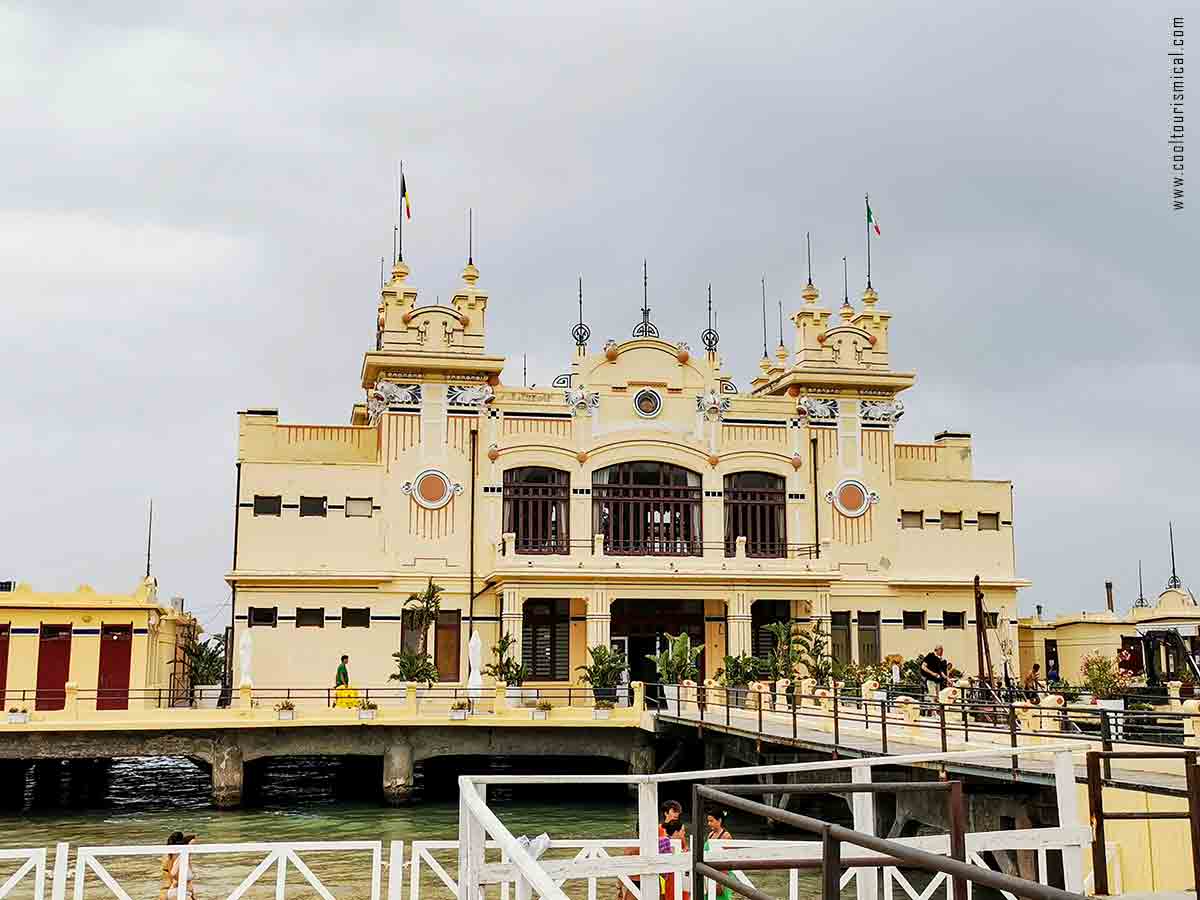
Ancient Bathing Establishment of Mondello, Palermo, Copyright © Cooltourismical.com
Liberty Style in Palermo refers to the Italian variant of Art Nouveau architecture and design, which gained prominence at the end of the 19th and the beginning of the 20th centuries. The buildings of that era feature curvilinear shapes, asymmetrical forms, and intricate ironwork. Facades are adorned with floral and botanical motifs, stained glass, and mosaic tiles.
Ernesto Basile is renowned for his contributions to the movement. His works include the Teatro Massimo and Villa Igiea, both of which are exemplary of Liberty Style.
Highlights: Mondello
Mondello, a charming seaside resort on the outskirts of Palermo, has been one of the areas embracing modernity and artistic innovation. It is well known for its stunning Liberty (Art Nouveau) style buildings, homes and public spaces. Antico Stabilimento Balneare di Mondello is the most iconic Liberty-style structure, sitting right on the beachfront.
It’s a must see, especially if you want to spend a day at the beach while visiting Palermo!
 Public Spaces
Public Spaces
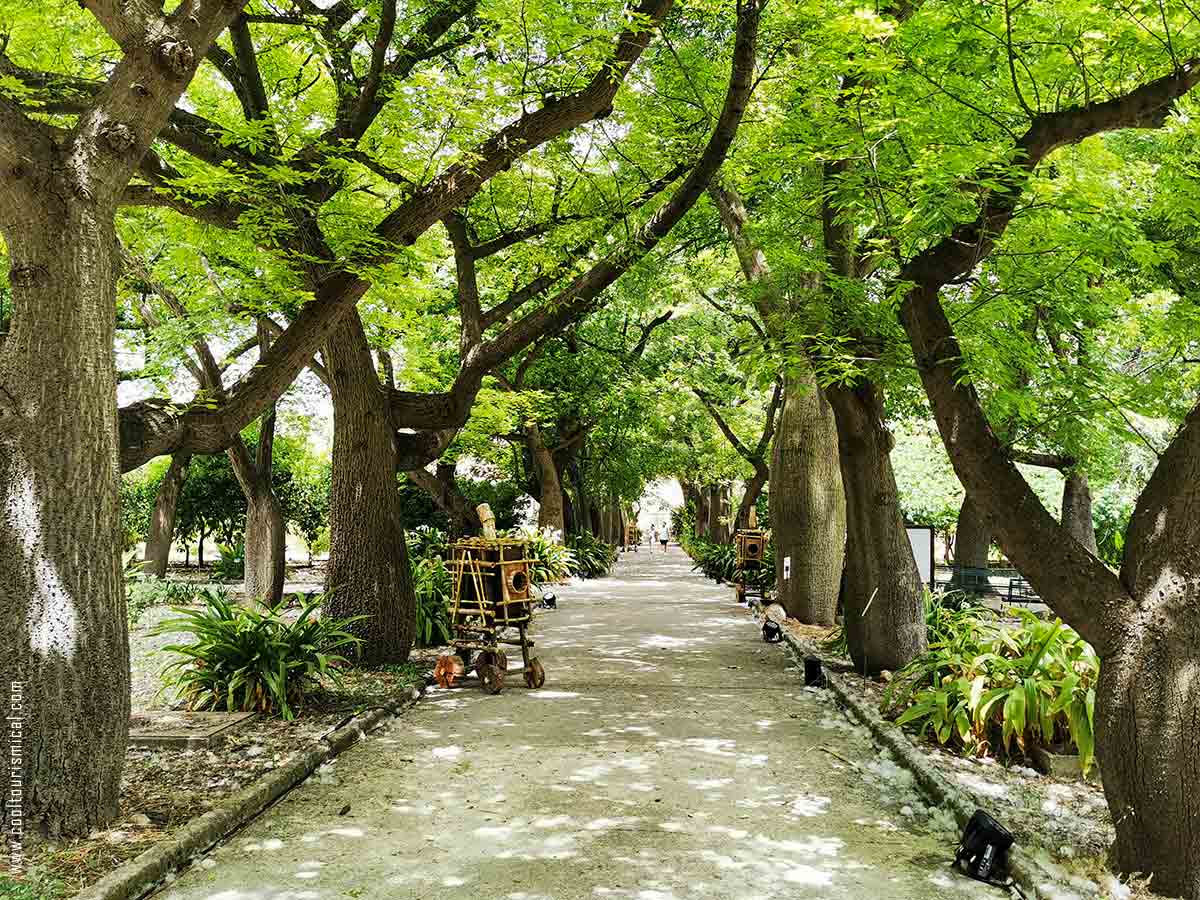
Botanical Garden in Palermo, Copyright © Cooltourismical.com
The city of Palermo is a museum itself, a city that’s easy to walk around, filled with lively markets, beautiful squares, and exotic green spaces. Architecture, art and culture embrace these public areas.
You can stroll through markets like Mercato del Capo, Vucciria and Mercato di Ballarò, where there’s always something new to see, smell, and taste. These markets are full of energy and local foods. You can read a bit more about them on this page: Ancient Markets of Palermo.
The city squares, like Piazza Marina and Piazza Pretoria, are great places to take a break and enjoy the surroundings. Piazza Pretoria is especially famous for its impressive Fontana Pretoria, a big, ornate fountain, I was speaking about earlier. And let’s not forget the Quattro Canti the cool spot splitting the four neighbourhoods.
Added to all that, Palermo also has lovely green spaces. The Foro Italico, a walkway by the sea, is perfect for relaxing walks with views of the water. The city’s gardens like Orto Botanico, Villa Giulia (Italian style garden) and Giardino Inglese (built on the English garden principles) are peaceful places to escape the busy streets, charming with their gigantic trees, cactuses, and lily ponds.
📌 Read more: The Heavenly Beautiful Gardens of Palermo You Must See to Believe!
 The City Gates
The City Gates
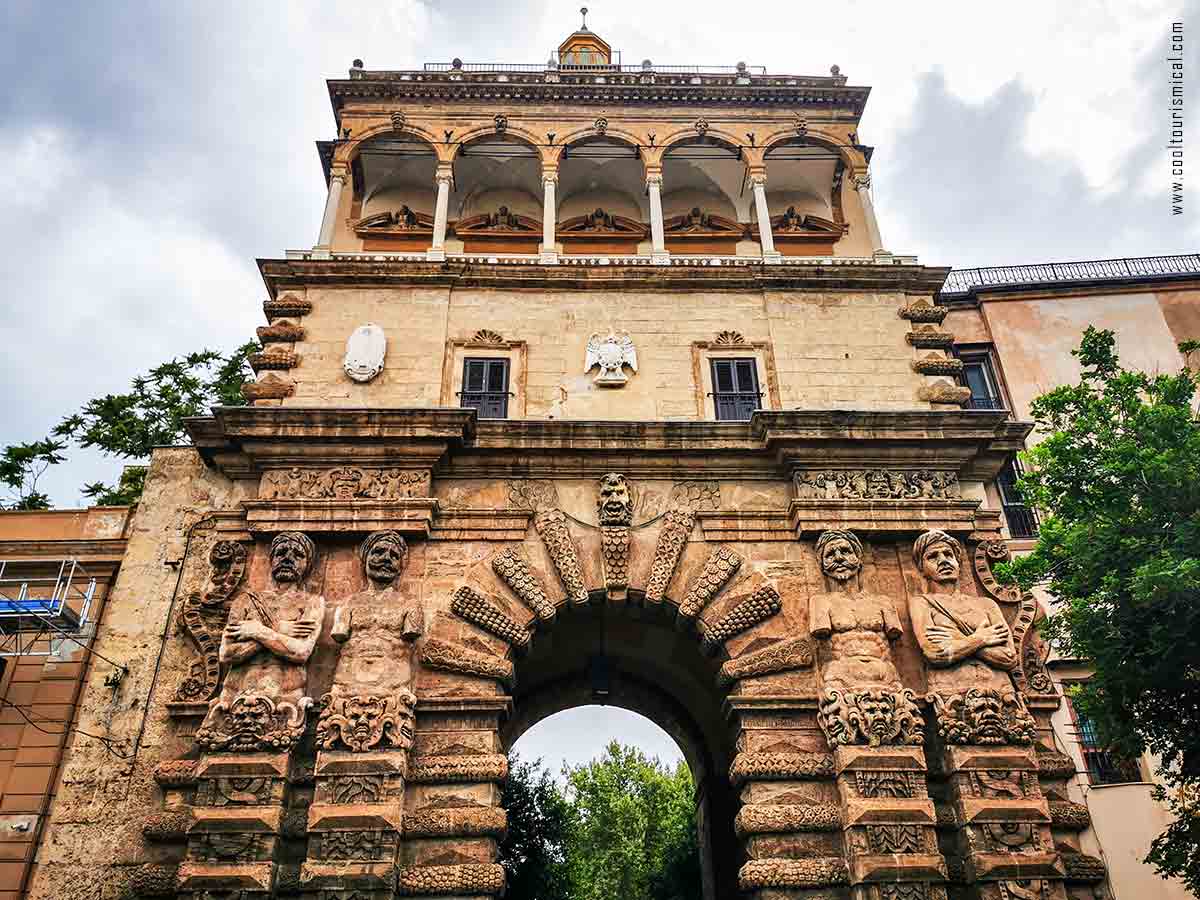
Porta Nuova in Palermo, Copyright © Cooltourismical.com
What about passing under some magnificent ancient city gates still standing?
The road from Norman Palace towards the sea goes along Via Vittorio Emanuele. At each of the street’s ends, there is an old, monumental gates: Porta Nuova on one side and Porta Felice on the other. These gates have such a beautiful appearance – with columns, balconies, and covered walkways in old styles from the Renaissance and Baroque times.
Porta Nuova was built first in the 16th century to celebrate Emperor Charles V’s win in Tunis and his visit to Palermo in 1535. It was rebuilt in the 17th century after a fire. Now, this gate is an important symbol of Palermo, showing a mix of Renaissance and Baroque styles, with Moorish statues covering the base.
Porta Felice came a bit later. The Spanish leader Marcantonio Colonna started it in the 16th century and finished it in the 17th century. He named it after his wife, Donna Felice Orsini. The outside of the gate, the part facing the sea, is decorated in the Baroque style with grey marble and sculptures. The inside part looks more like the older Renaissance style.
If this sounds fun, you can pass the gates on foot or by car. In case you want to get from Porta Felice closer to Porta Nuova, you can take Free Centro Storico bus. Yes, a free bus for tourists!! Though it’s a bit annoying as you can wait for it for a very long time. The first bus station is at Piazza Marina, nearby Porta Felice.
 Heritage Accommodation in Palermo
Heritage Accommodation in Palermo
Typical Modern Studio in a Palermo Old House- Can be booked here, Copyright © Cooltourismical.com
Maybe some of the most enchanting parts of visiting Palermo is that you can have SO MANY options of unique accommodation, including ancient buildings or famous landmarks. You can stay in a traditional Sicilian apartment or you can live in a refurbished palace or villa, for quite affordable prices sometimes.
On my first visit I rented a studio in the old center, close to Via Roma. And it was the studio in the images above.
Loved all details: the tiny balcony over a narrow street where Sicilians passed every day selling corn, a kitchenette to prepare our morning meals, a dedicated working space. And the design was thought to the smallest detail. It is also close to every important landmark (Teatro Massimo, the Cathedral, Fontana Pretoria) and just a few minutes walking from Vucciria market and piazza Olivella, filled with restaurants and good mood.
The studio can be booked here.
But for a second time, I would definitely go for a rooms inside the palace. The historic hotels below look pretty amazing.
Rocco Forte Villa Igiea
5⭐
A restored Art Nouveau villa, that feels secluded from the rush of the city, elegant interiors, lush gardens and spectacular sea views, across the Bay of Palermo.
Grand Hotel Piazza Borsa
4⭐
Upscale hotel, within 3 historic buildings, including a 16th-century cloister, with a panoramic roof garden and an amazing arcaded-portico, interior courtyard.
Conte Federico Apartments
4👍🏻
Luxury rooms in one of the oldest palaces in Palermo, in Vucciria market, guesthouse 400 m from Fontana Pretoria.
Eurostars Centrale Palace Hotel
4⭐
Restored 18th-century Palazzo Tarallo, with a rooftop bar overseeing Palermo old center, antique furniture decorated rooms, neoclassical and baroque details in common spaces.
Palazzo Sovrana
5⭐
Luxury, modern apartments in historic building, overlooking Teatro Massimo. The upper terrace, with views over the city, were used for filming the final scenes in The Godfather Part III.
Villa del Gattopardo
4⭐
Ex-summer residence of Prince of Lampedusa, one of the mansions that inspired his colossal work “Il Gattopardo”. Restored keeping the original architectural style & historic furniture.
 Palermo Architecture in the Movies
Palermo Architecture in the Movies
This absolutely lovely Sicilian city, with this completely stunning architecture, historic streets and scenic countryside, is as impressive for us as tourists as it is also for filmmakers. And if you already started preparing yourself for visiting Palermo, here are some of the movies that will make your experience even better.
These were either set in or filmed in Palermo:
- “The Leopard” (1963): Directed by Luchino Visconti, a classic film based on the novel by Giuseppe Tomasi di Lampedusa. It is cantered around the fading Sicilian aristocracy and features scenes shot in Palermo and its surroundings.
- “Cinema Paradiso” (1988): Directed by Giuseppe Tornatore, the film is set in a fictional Sicilian village, but includes scenes shot in Palermo. It’s a nostalgic homage to the experience of cinema in post-World War II Italy.
- “The Godfather: Part III” (1990): While most of “The Godfather” trilogy was filmed in various locations, some scenes from its third part were shot in Palermo, particularly those involving the Teatro Massimo.
- “Sicilian Ghost Story” (2017): Directed by Fabio Grassadonia and Antonio Piazza, the movie blends reality and fantasy, drawing inspiration from a true story. Love, enchanted forests and magical creatures based on the kidnapping of the child of a Mafia member. It features locations in and around Palermo.
 Recommended Reads on Palermo’s Famous Landmarks
Recommended Reads on Palermo’s Famous Landmarks
 Want to Add Something?
Want to Add Something?
If you have any comments, suggestions, amazing stories regarding historic architecture in Palermo, Sicily, that can complete my landmarks guide, drop me an email or write below. Palermo is one of my favourite places in the world and it would be great to have more information on this subject.

